#how small can you get and still function as a vertebrate?
Note
Quick, while the frog purists aren't looking, what's your favorite salamander?
No question, salamanders of the genus Thorius, the smallest salamanders in the world.

[Thorius pennatulus — src]
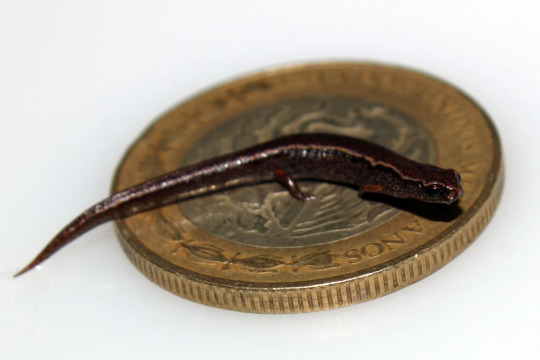
[Thorius sp. — src]
Truly astonishing creatures.
#Thorius#salamanders#caudata#amphibians#herpetology#these salamanders have a really shit surface:volume ratio#but they are LUNGLESS#so they respire entirely over that tiny surface#which is just astonishing#they also have ENORMOUS genomes#which means that they have huge cells#but they're small#so they don't have a lot of cells#they are pushing the limit to how small a vertebrate can be#and this is what I am going to be working on with my lab#how small can you get and still function as a vertebrate?#surely not much smaller than this#answers by Mark#anon#anonymous
901 notes
·
View notes
Note
Hey! Coming back to Kid Cosmic after a long time, and i want to ask you something! If Erodius got to destroy Earth, what do you think would be it's power? My mind says adaptation, but i want your opnion on it
I had to physically write down the rough draft of this so I could organize my thoughts properly; thanks for the brain teaser, Anon!
Obviously all the Stones’ powers are fantastical, but some of them ignore the rules of reality more than others. We can place them into three categories:
One: These are exaggerated versions of “powers” that exist in real life.
The Pink Stone gave Fry super-stretchiness (octopi).
The Magenta Stone gave Carla super-speed (cheetah).
The Purple Stone gave Hamburg an extra pair of arms (also octopi, spiders), doubling his ability to punch enemies, handle items, etc. The “exaggeration” part comes from the fact that all his arms were fully functional; while vertebrates are occasionally born with polymelia, these extra limbs are almost always a hindrance.
Meep the Puffball could grow to gigantic size, making her very strong and durable. The Blue Stone let Rosa do the same. Additionally, neither of them were restricted by the normal physics of Being Really Big; adult elephants cannot jump, and a beached whale will gradually be crushed under its own weight.
Two: These powers are inherently fantastical, but are similar to what real animals can do.
The Orange and White Stones let Ramona and Carlos breathe fire and ice, which is comparable to how some snakes can spit venom. There are chemicals that burn or freeze upon contact with the air, but none of them are naturally weaponized the way venom is! They could also produce fire/ice in much greater quantities than any snake can spit venom.
The Teal Stone let Carl become invisible, but it was genuine invisibility and not transparency (squid) or camouflage (chameleons). Additionally, he could still see while he was invisible, despite the fact that true invisibility would realistically require 100% of the light waves around him to not hit him- in other words, none would interact with his eyes, rendering him blind.
The Olive Stone let Flo turn her body into goo. While some animals can secrete slime to make themselves slippery, thus letting them squeeze through small spaces and avoid getting grabbed by predators, they aren’t actually composed of slime. Grabbing onto a struggling frog is difficult, grabbing onto a struggling pile of goo is nearly impossible!
Gortho the Gargarian could duplicate himself, similar to how many organisms reproduce asexually in some way (certain reptiles, fish, sea stars) or reproduce in large numbers to have a lot of disposable bodies around (ants, bees). The Yellow Stone let Papa G do the same. They also had the advantage of their copies retaining their memories, and the ability to duplicate tools and vehicles.
Three: There’s nothing in real life (that we know of lol) that can do anything like these powers, we’re shoving the laws of physics into a locker and stealing their lunch money here.
PT-SB had limited precognition, able to see dangerous events before they happened. The Red Stone let Tuna Sandwich do the same.
Mstr Wlkzn had telekinesis, the Green Stone let Kid do the same.
Queen Xhan has the ability to create portals, the Violet Stone let Jo do the same.
And the Indigo Stone let Chuck absorb/redirect energy.

Or, to put them on a spectrum from “less weird” to “more weird”, I’d order them Purple, Pink, Blue, Magenta, White/Orange, Teal, Olive, Yellow, Green, Violet, Indigo, and Red. (Though someone who knows more about biology or physics might order them differently.)
---
Mstr Wlkzn presumably didn’t consider telekinesis to be a “power” until he learned about and interacted with other aliens; from his perspective, it was a totally normal thing that everyone on his planet could do. Or almost everyone, no doubt some people had stronger telekinesis than others, with those who had very weak or no telekinetic ability perhaps being considered disabled.
Whatever power the Earth Stone would have would work the same way, it’s something most humans already have. (But since this is a sci-fi setting we’ll of course boost it up to superpower levels.) I like the idea of “adaptation”; depending on how you define it, using the categories from before gives us:
One: To borrow a bit from D&D, humans have a very high Constitution score in comparison to most other animals on our planet. Our endurance lends itself to pursuit predation; in other words, we can just follow prey until it falls over exhausted. Our omnivory lets us tolerate alcohol, caffeine, chocolate, garlic, onions, and many other substances that much of the animal kingdom considers to be poison. This Stone would basically make the user the Terminator, and would be Dark Green.
Two: Humans can adapt to their environment in a variety of ways, moving to a place with more sun darkens one’s skin, moving to a place with less sun lightens it, moving to a high altitude expands one’s lung capacity, etc. This power is more of a reach since presumably the other alien species can also adapt to various environmental pressures, but we don’t have any xenobiology textbooks that say otherwise so maybe humans adapt much more quickly/extensively than other aliens. This Stone would grant Shapeshifting, letting the wearer develop fangs and claws for fighting, scales for defense, fur for cold weather, gills for underwater, mimicry of other species for stealth, etc. It would be Iridescent. For the sake of not being OP, this Stone wouldn’t be able to mimic other Stone powers; the user could go as fast as a cheetah but not as fast as Carla, turn transparent like a squid but not become totally invisible like Carl, and so on. It could let the user mimic minor alien abilities such as Queen Xhan’s electricity or Meep’s ability to spit and regrow teeth, though.
Three: Presumably most of the aliens we see are like humans in that they are social species, but humans are social social. Our heroes outright robbed Boss Fiosa, a murderous crime lord, and she still showed up to help them out because they were such nice caterers! This is The Power of Friendship! Or, rather, Charm, a subtle psychic ability that would get others to like the user more. It would also help the user learn and mimic alien body language and customs. This Stone would be Bronze, a warm orangey-brown.
---
This was probably more of an answer than you were expecting, I got a little lost in the sauce with regards to all the biology facts XD
6 notes
·
View notes
Text
Herd Immunity and the Anthropocene
When is getting an infection actually a good or a bad thing? Let’s start by talking about herd immunity. What exactly is it, and why have we been hearing about it so much during the Covid-19 pandemic?
Herd immunity, as described by the CDC, is a situation in which a sufficient proportion of a population is immune to an infectious disease (through vaccination and/or prior illness) to make its spread from person to person unlikely. When a group has a high enough percentage of immunity in its population, transmission becomes increasingly difficult for a disease to spread to even the more immunocompromised members of the community.
Although, herd immunity is obtained at different levels of community immunity depending on the disease. Some highly infectious diseases, such as measles, require about 94% herd immunity to stop community spread. According to the Mayo Clinic, about 70% of the US population would need to have immunity from Covid to stop our current pandemic.
So how do we even get herd immunity? Well, we can achieve herd immunity through two different methods. The first method is infection. Herd immunity can be achieved by having a large amount of the population getting the virus naturally. The downside of this method is that the population has to get sick and recover. Depending on the disease, short or long-term side effects or mortality rate can be very detrimental to the population.

Germs have most likely existed for around 3.5 billion years (the age of the oldest living organisms, bacteria). Modern humans have only been around for about 130,000 years. Humans have only been around for a fraction of the time diseases have, but they are both a part of nature. However, in response to their presence, humans have developed immune systems that have been a part of a back and forth protecting us from harmful germs. Terrestrial vertebrates such as humans have complex immune systems that have evolved to protect them from new immunological dangers. Getting sick is a part of life. Diseases have always been a part of nature, and that is especially true of the current time period, the Anthropocene. The Anthropocene is the current geologic age where humans have a substantial effect on their environment. During this time period, the way we interact with nature through contributing to climate change, deforestation, and urbanized lifestyles has increased the likelihood of pandemic-like illnesses to sweep over our communities. Deforestation causes loss of habitat; and with loss of habitat animals will be forced to come into contact with animals they originally wouldn’t have, including humans. This increases the chance for germs to spread to new hosts. Climate change and urbanization are also causing organisms to live closer together, allowing for diseases to spread more easily through communities. So, while diseases are a part of life and nature, occasionally there is one germ that can come around and have a profound effect on society.
I remember the news stories when NYC was first getting taken over by Covid. Medical personnel lacking PPE, hospitals overflowing, using ice trucks to store the deceased, and exhausted nurses and doctors. All of that resulted in just 22% herd immunity. At 22% herd immunity most of the population of NYC is still susceptible to Covid. If natural infection was the only way forward, so many more of NYC’s citizens would die or become severely ill. However, because this happened NYC was quick to understand the importance of instituting mitigating measures to slow the spread of the disease. Andrew Cuomo, the governor of New York, is similar to Rand Paul in that he is in a position that he can implement policies. When Andrew Cuomo, governor of New York, saw what was happening in his state, he used his ability to implement policies to follow scientific guidance surrounding closures, social distancing, masks, etc. As a result, the rates in NYC decreased. Not because of herd immunity, but because of serious measures against Covid. If we look at a different state, such as Florida, that did not take measures against Covid seriously, there were consecutive days in the state where they were having 10,000 to 15,000 new cases a day. This lacking approach to Covid caused thousands of preventable deaths. Even after months of lockdown the US is not close to herd immunity. All of the preventable deaths and long-term health complications that I’m seeing in people are going to continue with the natural spread. This is why the global race for a vaccine is so important.
The second method of reaching herd immunity is through vaccinations. By developing a vaccine for an infectious disease, we are able to reach herd immunity without having to subject our population, community, and families to the side effects and overall awful experience of falling ill. By using widespread vaccinations, we can also protect our most vulnerable members of society, like our loved ones in an older or younger age range, immunocompromised individuals, or those with allergic reactions making them unable to receive vaccines. Herd immunity is a good thing. When we have a disease like Covid, however, natural infection will cause crippling long-term effects in what were healthy people, and hundreds of thousands of preventable deaths. This is why herd immunity is good, but it depends on the method used to obtain it.
Immunity is an important part of preventing diseases in my home. Herd immunity helps me protect my family, friends, and people I come across every day. When paired with vaccines, I am able to protect more people in my community. I have a small child in my home, and older family members who I come into regular contact with. My family (my herd) and I get our vaccines and flu shots every year to help protect those more immunologically vulnerable members of our family. By doing this, my herd is creating a mutually benefiting environment where our personal actions protect those around us. The actions that we take to protect our family also protect the members of our communities and your herd too.
Humans are a part of nature, and so are diseases. Individual actions have a larger inter-connected effect on surrounding environments and society. The same thing could be said about the Covid virus spreading through the country. Society as a whole needs to develop a larger scope of thinking about how the actions of individuals affect the environment and planet. The factors I mentioned earlier, climate change, deforestation, and urbanization, are keeping steady and increasing. If these continue as they are currently, we can expect more pandemic-like diseases in our future. And when it happens, society will have to come together again to figure out the best way of adopting herd immunity to combat the disease.
As for my advice for the rest of this year, think critically, look at scientific data, vaccinations work, and in the words of Mr. Rogers, “Real strength has to do with helping others.”
Hannah Smith is an intern in the Section of Anthropocene Studies. Museum employees are encouraged to blog about their unique experiences and knowledge gained from working at the museum.
Works Cited
Glossary
Acquired Immune Deficiency Syndrome (AIDS): A medical condition where the immune system cannot function properly and…
www.cdc.gov
https://www.cdc.gov/vaccines/terms/glossary.html#commimmunity
Herd immunity and COVID-19 (coronavirus): What you need to know
Understand what's known about herd immunity and what it means for coronavirus disease 2019 ( COVID-19). Curious as to…
www.mayoclinic.org
https://www.mayoclinic.org/diseases-conditions/coronavirus/in-depth/herd-immunity-and-coronavirus/art-20486808
Vaccines Protect Your Community
Did you know that when you get vaccinated, you're protecting yourself and your community? This concept is called…
www.vaccines.gov
https://www.vaccines.gov/basics/work/protection
Anthony S. Fauci, M.D.
Dr. Fauci was appointed director of NIAID in 1984. He oversees an extensive portfolio of basic and applied research to…
www.niaid.nih.gov
https://www.niaid.nih.gov/about/anthony-s-fauci-md-bio
https://www.nytimes.com/2002/02/26/science/when-humans-became-human.html
https://www.nationalgeographic.com/science/prehistoric-world/precambrian-time/
https://www.britannica.com/science/immune-system/Evolution-of-the-immune-system
https://www.hsph.harvard.edu/c-change/subtopics/coronavirus-and-climate-change/
https://www.inc.com/geoffrey-james/45-quotes-from-mr-rogers-that-we-all-need-today.html
26 notes
·
View notes
Text
Pachycephalosaur domes: Function
Welcome back! We last left our heroine (that’s me!) as she gave a brief overview of the history of interpretations of pachycephalosaur domes. We now return to your regularly scheduled program.
However, little discussion was had of the function of the pachycephalosaur dome in this early work, with suggestions limited to the broad category of “armour” (ex: Gilmore, 1924).
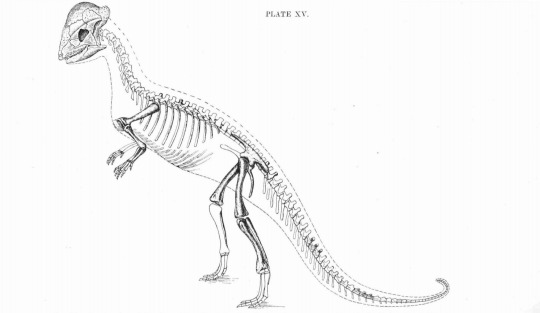
(Image: A skeletal restoration of Stegoceras validum showing pachycephalosaur anatomy as known in 1924. Outlined parts are inferred from comparison with Hypsilophodon. Image from Gilmore (1924).)
The first worker to propose a functional use of pachycephalosaur domes was Edwin Colbert in 1955, who compared the domes to the cranial “bosses” of artiodactyls and suggested that they may have been used similarly in head-butting battles - here used to mean head-to-head smashing contests - over mates.
Galton (1971) thought this was a pretty boss idea, and pointed out that the domes of pachycephalosaurs were made of very thick solid bone. Bone takes a lot of energy to maintain; despite looking like a static, dead rock, it is in fact a living tissue that is constantly remodeling itself (hence why you can repair after a broken bone!). If the domes were just for display, Galton argued that it’d be much more beneficial for them to be hollow. (This would also make them lighter to carry around.)
This still left the suggestion of the dome being used as an anti-predator weapon. Galton argued that this also was unlikely — after all, if something is trying to kill you, why not have a sharply pointed head instead of a dull, rounded one? Finally, Galton pointed out that the neck articulation was rotated to the bottom of the skull, a condition that we’ve seen is extremely rare among animals. He argued that this was an adaptation for transferring stresses away from the brain and into the body after two pachycephalosaurs bonked heads.

(Image: *Bonk*. <Drawings of pachycephalosaur skulls bonking into each other, with arrows showing his interpretation of how forces would be transferred>. From Galton (1971).)
Sues (1978) agreed that the thickening of the skull functioned to reinforce it for use as a battering ram. In order to see whether it had any structures that indicated special adaptations for bonking heads, he cut a pachycephalosaur dome open and looked inside it.
Modern animals that butt heads with each other are, of course, in danger, because the skull contains the brain, which is a part of the body that you generally don’t like getting sloshed around. A completely solid dome, while very durable, might thus not be the best way to go if you’re bonking into things. This is because it would lead to all forces traveling directly into the brain, without absorbing any of the impact. A more springy dome that keeps its strength but can deform would mean that that stress gets reduced. It’s the same reason why modern cars are designed to crumple to keep you safe.
So in order to counter that, modern head-butting mammals have hollow areas on their heads that are reinforced on the inside with bony struts. Here’s an example of that in a Cape Buffalo:
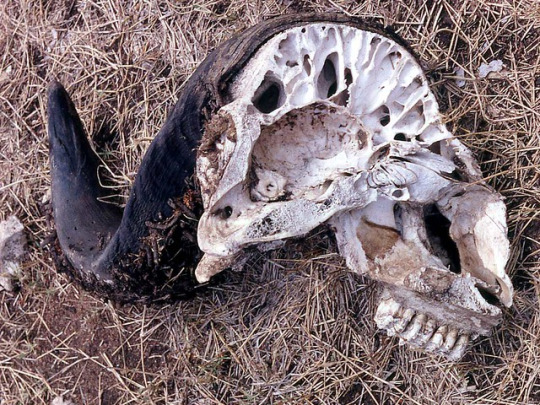
(Photo: The skull of a Cape Buffalo (Syncerus caffer), which has broken open, revealing a complex series of sinuses and body struts under the horns. Source)
So what did Sues find when he cut open the skulls of pachycephalosaurs? See for yourself:

(Image: A thin section through the dome of a Stegoceras validus - this section is cut from “ear to ear”, if that helps you imagine it (though note that their ears weren’t quite in the same place as ours; this is just to help clarify what’s being shown here). I’ll describe anatomically what’s going on in the next paragraph. Image from Sues (1978).)
First things first, those big cracks are not anatomical features; so far as I can tell, they are just cracks in the specimen. What we’re really looking at here are the much smaller bony struts and cavities that radiate away from where the brain would be towards the outside of the skull. Sues termed these radiating trabeculae, and argued that they served a similar function to the sinuses in buffalo. They are not nearly as big as the ones in buffalo, but Sues suggested that differences in brain size and structure might have meant that such protection wasn’t as necessary in pachycephalosaurs.
This idea that the pachycephalosaur skull could resist stresses was elaborated on by Snively and Cox (2008), who, using computer models, demonstrated that point stresses applied to higher-domed skulls would diminish rapidly with distance from the point of contact. They found that flat-headed pachycephalosaur skulls would propagate stresses through their structures far more. Based on these results, they predicted a high occurrence of injury to the surface of the dome.
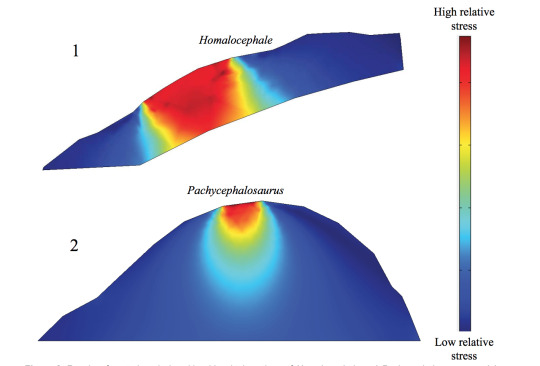
(Image: Biomechanical computer models of the flat-headed Homalocephale and the dome-headed Pachycephalosaurus. The former shows high stresses throughout the “dome”, while the latter shows stresses diminishing near the point of contact.)
Their predictions were confirmed by Peterson et al. (2013), who examined domes across pachycephalosaur diversity for evidence of injury. Fully 22% of specimens observed showed injuries to the frontoparietal dome, and 7% of specimens had 6 or more lesions. This is an insanely high frequency of injury, and lends some support to the idea that they were hitting their heads against something. Injuries were concentrated near the peak of the dome, as might be expected were domes used in butting behaviour; all flat-headed specimens examined lacked head injuries.

(Image: Six different pachycephalosaur domes, all with surface injuries (indicated with white arrows). Image from Peterson et al (2013).)
Snively and Theodor (2011) offered comparisons to modern head-butting mammals including giraffes, musk oxen, and duikers by examining bone density. Their results showed that pachycephalosaur cranial domes exhibit particularly dense bone superficially but much less dense bone as one moves deeper into the dome, a pattern seen also in head-butting artiodactyls, and suggested that this supports them using their heads to hit things with.
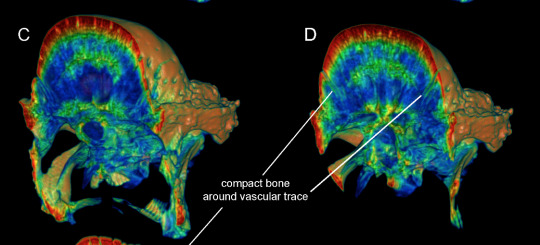
(Image: Scans through the skull of Stegoceras, showing higher bone density in red and lower in blue. Higher-density bone is concentrated towards the outside of the dome, with lower-density bone inside. Modified from Snively and Theodor (2011).)
Modern animals that butt heads typically have broad-flat surfaces (as in bighorn sheep) or otherwise branches or structures to maintain contact (as in ibex, for example). Pachycephalosaurs have neither of these, instead having rounded domes; if two ran at each other, it is easy to image how they might glance off each other and injure their necks. Sues (1978) thus argued that the domed shape might indicate flank-butting (in which animals would ram each others’ sides).
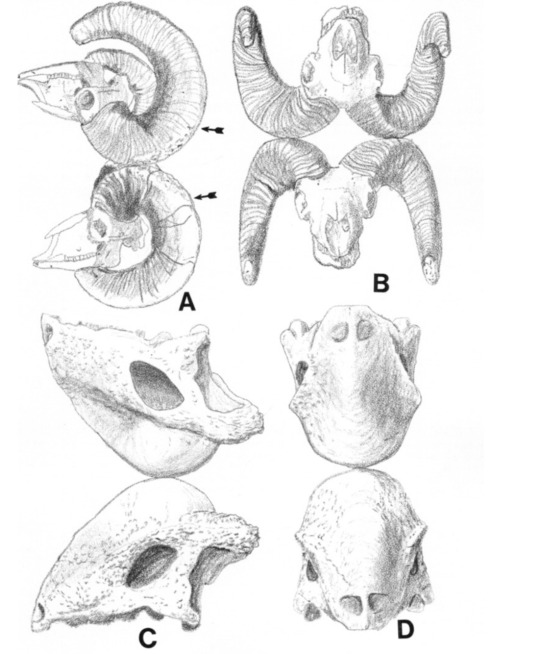
(Image: Problems with pachycephalosaurs bonking heads. Modern bighorn sheep skulls have wide surfaces of contact, while pachycephalosaurs would have only a very small point on the top of a round dome. Image from Carpenter (1997))
This was elaborated upon by Carpenter (1997), who noted that the head-butting hypothesis supposes that the skull and vertebral column act in a straight line to transmit forces through the body (rather than into the neck). Carpenter observed that, though no complete neck is known from a pachycephalosaur, the orientation of the back vertebrae and of the socket on the skull necessitate a gently S-curved neck and back, as in most ornithischians. As such a curved neck would transmit stresses diagonally on the spinal column, it risks breaking the neck. Today’s head-butting mammals solve this problem by having tall spines on their neck and back vertebrae, but these are not present in pachycephalosaurs.

(Image: Schematic drawing of a pachycephalosaur skeleton, showing S-curved neck and transmission of stress shear-wise to vertebral column. Modified from Carpenter (1997).)
He agreed that flank-butting was a more likely use of pachycephalosaur domes, pointing to similar behaviour in modern African antelope. Finally, Carpenter pointed to the wide ribcage of pachycephalosaurs as possible evidence of thickening the torso to better protect against butting behaviour.
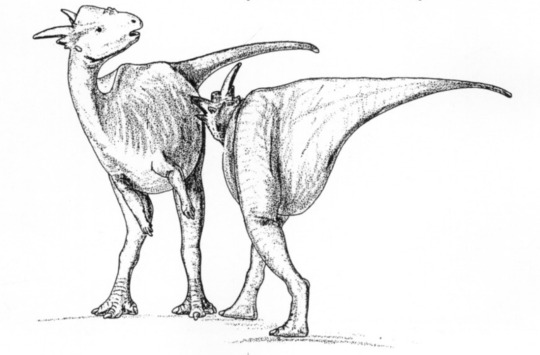
(Image: Drawing of two pachycephalosaurs butting each others’ flanks. Modified from Carpenter (1997).)
Goodwin et al (1998) agreed about flank-butting, and also believed that the structure of the dome would not have offered protection against stresses as the trabeculae were not interconnected. Instead, they interpreted the structures instead as artefacts of rapid growth of the dome.
Bony reinforcements of the tail are pretty common in dinosaurs; they are most extensive in the “duck-billed” hadrosaurs, in which the tendons of the back have turned to bone and effectively make the entire back and tail stiff and unable to move.
Pachycephalosaurs have similar-looking structures on their tails, and Goodwin et al. suggested that the reinforced tail of pachycephalosaurs may have served a role in flank-butting behaviour, offering that it may have been used as a defensive weapon against other pachycephalosaurs.
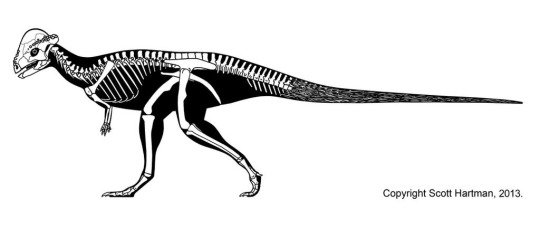
(Image: Skeletal drawing of Stegoceras. Note the complex “basket” of bones reinforcing the tail. Image by Scott Hartman @skeletaldrawing.)
However, the idea of the tail as a defensive weapon was rejected by Brown and Russell (2012). These authors demonstrated that, amazingly, the “basket” of bones reinforcing the tail are not tendons, but instead the divisions between the individual muscle blacks that have turned to bone! This is a condition that’s unknown in any other tetrapod (though it’s present in some fish). Due to the location of the ossifications within the muscles rather than the skin, these authors argued that it would not be useful as a weapon. These authors instead suggested that the the tail served to brace the body in a tripodal stance during flank-butting, an idea first proposed by Maryańska and Osmólska (1974).
The first major objection to be raised against generalised butting behaviour in pachycephalosaurs was by Goodwin and Horner (2004), who sliced into the domes of pachycephalosaur skulls of different ages. Building off of work done by Goodwin et al. (1998), they argued that the “radiating trabeculae” that had been cited by previous authors as being adaptations for reducing strain on the brain are instead temporary features associated with the rapid growth of the skull and disappear as the animal ages, and that the shape of the adult dome was ill-suited for dissipating stress.

(Image: Thin sections of two pachycephalosaur domes, the left from a younger individual, the right from an older individual. Stage II (the less dense, spongier bone) is propotionally thicker in the younger individual. Images are not to scale. From Goodwin and Horner (2004).)
The authours instead argued that pachycephalosaur domes functioned as species-recognition characteristics, as they were apparently not sexually dimorphic (to be discused in a future post, which will be linked here).
This idea received criticism for failing to address why animals would evolve such thick and dense structures if they were just for display, and I confess I don’t buy the idea at all. . Lehman (2010) also took issue with the characterisation of the dome histology, concluding that the radial structure of the bone was present even in the most superficial, densest bone zone, albeit with a decreased amount of vascularity; and that the less compact, vascular bone was maintained at least until the individual attained adult size. He further noted that trabecular struts of a form similar to those found in pachycephalosaur frontoparietal domes are strongest against compressional stress along their long axis, consistent with high strength in pachycephalosaur domes.
Longrich et al (2010) argued that the dome could not possibly have functioned in species recognition, because dome shape is not significantly different between different species — an observation that, to my view, is an extremely convincing argument against the “species recognition” idea. These authors also pointed out that some degree of asymmetry was not uncommon in pachycephalosaur domes, and noted that this is a common trait of featured which have been sexually selected (both in display structures and intra-specific weapons).
This was a bit of a longer post this week, but I wanted to make sure I had a good overview of different proposed functions of the dome. This series will conclude next week with a look into who had the dome, and finally what I think they were doing with it! A link to that will be >here< once it’s up.
428 notes
·
View notes
Text
Vertebrate Wings, PART 6: Details
Return to main post + TOC >>HERE<<
Details TOC
Elbow Spines
Wrist Spikes
Palms
Thumbs
Elbow Spines
I was admittedly a LOT more anal about elbow spines in the past. No way no how, I didn’t accept elbow spines in any way, shape, or form. Nowadays, I’m simply wary of elbow spines. I still believe whole-heartedly that a proper wing will have enough membrane stability and surface area all on its own, without the need for an elbow spine. BUT I can absolutely see the aesthetic charm in certain designs, and elbow spines can make sense if designed properly.
The interesting thing is that there ARE real-life “flying” animals with elbow spines—anomalures.


(I honestly wish I had skeletals to show off but I can’t find any, so if anyone has anomalure skeletal photos/diagrams I’d greatly appreciate it)
Technically these animals can’t “fly” but glide, much like the similar (but not necessarily related) flying squirrels, who also happen to have ‘spines’ at their wrists.
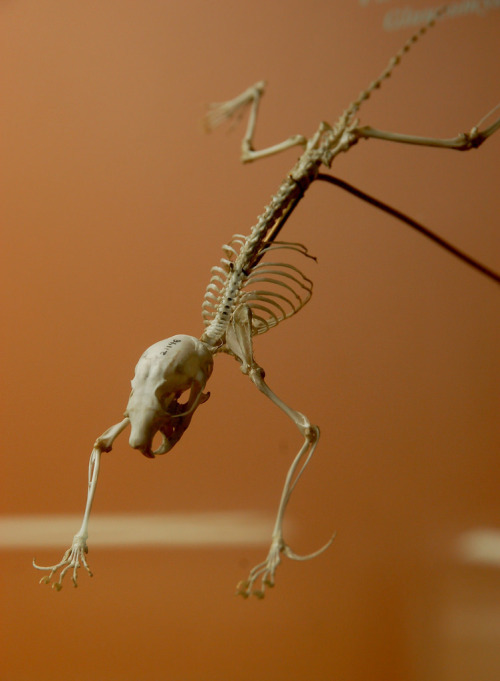
Even the recently discovered Yi Qi could be used as comparison, with their highly-elongated wrist spines.
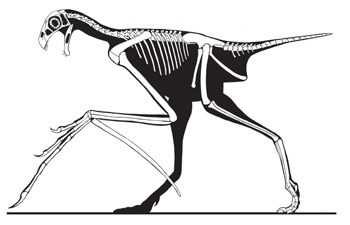
Despite these real-life animals with wing spines supporting their membranes, there are still ways to do wing spines wrong, so keep these tips in mind if you want to add elbow spines to your creature’s membranous wings:
1) Animals with these spines are GLIDERS
The living animals with similar spines—flying squirrels and anomalures—are gliders, NOT powered flyers. IE—these animals don’t flap or otherwise move their arms/legs in very complicated motions; their limbs/spines are almost exclusively built to keep the membrane taut during gliding. While we can’t know of the Yi Qi’s specific style of flight at this point, I have reason to believe they were also gliders, not flyers. Again, I can’t prove this for certain, it’s just what I can reason out from what’s currently available about the species.
Either way, evidence points to the idea that these sorts of spines (at least supporting the main body of a membrane—yes I know about pteroids) are exclusively found on gliders, not powered flyers. This makes sense, given that spines don’t have joints, so they wouldn’t give membranes NEARLY the same flexibility and precision as fingers. But since gliders don’t necessarily need that kind of precision, this doesn’t hinder their “flight”.
Now, this fact on its own doesn’t negate the possibility of elbow spines on a powered flyer, but it is a cautionary reminder to take proper integration into account, which the following points will describe.
2) Spines are NOT fingers
Elbow spines are not endemic to arm structures—the structures wings evolved from. Thus, an elbow spine would have had to evolve into a wing design for the express purpose of membrane stability and/or widening the membrane surface area.
There is absolutely zero reason an elbow spine would have a claw, pad, or otherwise be implied to be a modified finger. Fingers are based exclusively on the hands (and feet, if you want to get technical), and would NOT migrate down to the elbows just to expand the wing membrane. Hell, even most of the ACTUAL fingers of bat wings don’t have any claws (besides the thumb of course) because claws on the tips of wing fingers are usually useless, since there’s no feasible way to use them for clinging, digging, or scratching purposes. Plus, claws/padding add unnecessary weight to the tips of the wing fingers, which SHOULD be the thinnest/lightest part of the wings, sans open membrane. Claws are only really useful on the shortest, front-facing fingers of bat wings.
However, I will acquiesce that jointed spines aren’t entirely unbelievable. I personally don’t know of any real-life animal with jointed spines, but I don’t think that joints would be necessarily exclusive to fingers. Unlike claws or pads, joints would provide a distinct purpose to the wing by allowing the spines more malleability and delicate control of the wing membrane shape.
3) Try not to interrupt the elbow joint
Again, I would appreciate an anomalure skeleton here in order to see exactly where the elbow spine attaches on the arm, but I guess we’ll have to wait on that.
Sans the anomalure (whose elbow structure is impossible to see under the fur), I don’t know of any cases of real-life animals with 3 different, independently-moving bones sharing the same joint (I’m not counting wrists/ankles here considering the specialty of the carpal/tarsal-based joints).
As it is now, I advise caution when placing the base of the spine at the elbow. It may certainly work, especially if the underlying bone/cartilage base of the spine “floats” a little ways away from the elbow itself, as can be seen in this EXCELLENT Dragon skeletal by Sammy Torres, yet again--
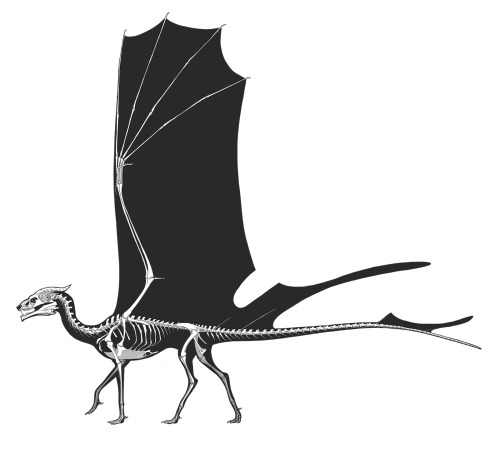
But please, do NOT slot the elbow spine directly INTO the joint between the upper and lower arm.

This would block the range of joint flexibility and important muscular connections between the upper and lower arm.
4) Try to form a paddle
As explained in the Membranes and Feathers section, a bird’s remiges are ONLY based in the bone of the lower arm and hand sections. This helps to form a more stable “paddle” out of these sections of the wing, while other feathers (tertials, axillaries) simply close the gap between the body and the remiges.
While feathers shouldn’t be conflated with membranes, I think in this instance they provide a decent reference for spine placement, since many birds are powered flyers. Thus, if the spine isn’t based at the elbow, I think basing the spine on the lower arm just past the elbow itself would work just fine.
Either way, definitely DON’T put a spine on the UPPER arm—it would just be useless. The membrane is already so close to the body on the upper arm (considering how short the upper arm typically is compared to the lower arm) that any extra stability or widening of the membrane isn’t going to do much good. Plus, it would be rather uncomfortable to fold a spine against the body on the upper arm.
Wrist Spikes
(Not to be confused with spines, which I use to refer to projections that support a membrane. See above sub-section for those)
This is yet another anatomical detail I was MUCH more anal about in the past, before learning that many real-life birds actually do have wrist spikes called wing spurs (and clubs, spikes, etc.).
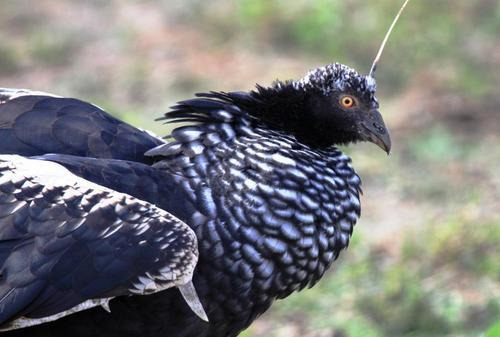
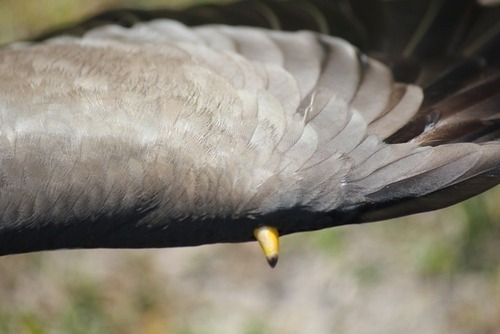
Some have even retained claws on the ends of their fingers.

The claws are the easiest to understand—they’re retained from birds’ clawed ancestors. The spikes and spurs, however, are a bit novel to our human understanding of anatomy, as they can sprout from the metacarpals, carpals, or even the radius of the arm!
The takeaway here is that these spurs/clubs/etc. are used exclusively as weapons (whether against their own or other species). Thus, they are firmly based on an already-present bone (either the carpal, metacarpal, or radius), and don’t move independently. They don’t provide any help in clinging, nor can they fold up against the wing like bat thumbs.
(I highly recommend checking out Darren Naish’s articles on wing spurs if you want a much more in-depth analysis of wing spurs in different bird species)
Just keep the basic anatomy of the hand in mind if you add wrist spikes. For example, if your wing has a thumb, then you’d likely need to base the spike on the radius rather than the wrist bones, or else the spike would interfere with thumb movement. Also be careful not to interrupt the front-edge membrane when adding wrist spikes—wings still need that membrane to function, whether they’re being used for battle or not.
Palms
Now I know I said in the Basic Anatomy section that bats don’t have palms-- just wrists carpals and extra-long fingers. This is likely because of what I discussed in that section about proportions-- the longer bones forming bases of the fingers provide stability to the fingers, while the carpals simply hold all the fingers together at one point, allowing for rotation and flexibility. A proper palm may end up destabilizing the wing, since the base of the hand needs long-bone stability, but the bones of the palm would be shorter than the bases of the fingers.
However, this is merely a possibility-- while palms aren’t technically accurate to real-life bats, I don’t think they’re necessarily impossible, if designed right.
Namely, we need to keep in mind weight and shape.
The wing palm should NOT be too thick/wide relative to the wing arm, since the overall mass of the wing thins out across the arm, from shoulder to wrist. thus, if you slap a heavy palm on the end of the wing, it’ll throw off the whole balance of the wing.
Shape also affects the stability of the wing-- the leading edge of the palm may need thicker support against oncoming air currents, while the trailing edge might thin out some to help with aerodynamics.
So, we can assume that a humanoid palm would be too thick with padding, too large proportionally to the arm, and not shaped correctly for flight.
Instead, I would suggest a couple options.
You could slightly emphasize the wrist space the bases of the fingers share, making for a round, unobtrusive palm. Hell, you might even be able to argue the palm is *just* the carpals, depending on how you draw it-- it’s just a little wider than on bats.
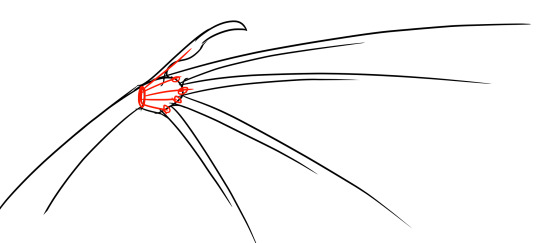
Or, you could lean into a longer, but more asymmetrical palm, with a thicker leading metacarpal, and the rest of the metacarpals shortening/thinning in progression.

Just remember that with either design, the palm should still be fairly small compared to the arm.
Thumbs
When thumbs aren’t being used as a base for feathers like a bird’s alula, they’re usually used for clinging. As it turns out, clinging is more effective when the knuckle of the thumb rests against the object being clung to, thus this knuckle gets a lot more padding than the rest of the finger.

This padding could even be compared to the paw pads of a cat or a dog, especially when the thumb is used as a resting point when bats are on the ground.
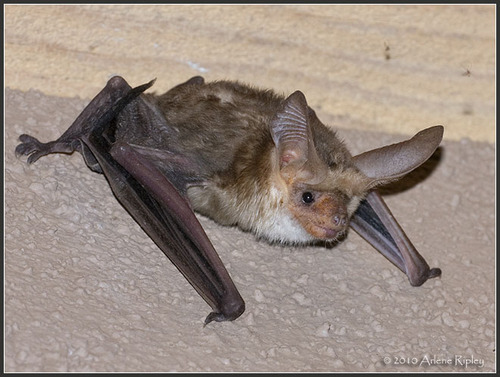
While I wouldn’t necessarily consider it a sin to model a wing thumb after a human thumb, it does make more sense to model wing thumbs after bat thumbs so they can properly cling and support a membrane.
-Mod Spiral
7 notes
·
View notes
Text
Thief’s Apprentice: Magical Beings
Note: I mean magical beings in the sense that every being in a discrete group is magical. For example, a human or a wooly mammoth or fig tree can all be mages, but it doesn’t mean all humans, wooly mammoths, or fig trees are mages. All of these beings are mages. The World was once populated with magical beings, but after they all mysteriously died while turning human, there have been very few magical beings on The World. However, disease, soul experiments, and mass prayer have caused humans to become magical beings again.
Revenants
There are about a hundred million revenants on The World.
We already know about revenants. A plague turns vertebrates into necromancers after they die, who come back to life as a walking corpse. Revenants have no physical senses. Revenants feel the emotions they felt as they died the strongest. The longer you had the plague, the saner you will be after death. Revenant souls regenerate quickly and grow continuously, becoming huge enough to allow them to perform powerful magic without consequence.
We have taken a very revenant-centric view of The World so far, but there is so much other shit going on.
Ambient Creatures
There are countless trillions of Ambient Creatures on The World.
The World was once covered with Ambient Magic strong enough to support large creatures through magic alone, but they have shrunk almost to disappearing. Some believe the loss of Ambient Magic coincides with the mass extinction of magical creatures, but there’s no proof of this. There are still a few patches of Ambient Magic scattered throughout The World, but they collectively take up less than 100 square miles and are too weak to support anything but small and simple creatures.
In the last few hundred thousand years, some previously nonmagical animals have evolved to take advantage of Ambient Magic. All beings with souls can absorb and make use of Ambient Magic, which only amounts to feeling slightly more emotionally stable. However, this is enough to sustain some beings, like the flatworms, which eat nothing and lazily float about, needle snails, which eat and behave like normal snails but have the ability to shape iron sand into spikes using Industrial Magic, and lambent butterflies, which use Light Magic to flash and turn invisible, but revenants don’t see using light anyway so it literally does not matter. When removed from Ambient Magic, ambient creatures will lose all magic ability, and in some cases, die quickly. There are many species that are indistinguishable from nonmagical species, but when they are placed in Ambient Magic, start performing powers. Some of these species are found nowhere near Ambient Magic. How did they get there? Maybe it’s the Ambient Magic that moved.
Parts of Ambient Creatures can be used to make powerful magic items because they evolved to store a specific type of magic.
In Veilheim, the Ambient Creatures in the Magical Grove outside the city are seen as further proof that invertebrates are Perfect Forms.
Vampires
There are about fifteen thousand vampires on The World.
120 years ago, Dr. Hanna Ferse, an infamous Gore Mage from Hapsburg, was able to reverse engineer the original plague-transmitting neuroleprosy bacteria into something she hoped would save humanity from plague. It sort of worked. Vampirism renders its bearers immune to plague, but vampirism is arguably worse than the plague. Instead of turning the dead into necromancers, it turns the living into gore mages. Given that vampirism still draws upon The Necromancer’s magic, this has terrifying implications as to The Necromancer’s true power. While being a vampire prevents plague, being a plaguebearer also prevents vampirism. Vampirism only infects humans. Interestingly, mages, wizards, and other people with unusually large souls are immune to vampirism.
Vampirism is transmitted by bodily fluids, has a ten hour incubation, then in one hour turns bearers into vampires while they are still alive. If bearers don’t deprive themselves of water and eat salt past the point it’s physically painful, they will die. Their bodies have been modified to function best when very salty, but they still have the same survival instincts as humans. A healthy vampire suffers from constant thirst, but if they drink too much of anything with a lower salinity than blood, they will get sick and die. Vampires can also die in all the ways a human can die, such as starvation and bleeding. Vampires are also very dense and quickly sink in all bodies of water. Being in contact with freshwater for too long will cause mass cell death and their skin to slough off. Vampires also get very stiff and develop a grainy pallor as more of their bodies are replaced with salt. Many vampires get strokes and kidney stones and go blind because of high blood pressure, and also their blood is so thick with salt crystals it starts cutting into surrounding tissue. Being a vampire sucks because you need to turn into a cured ham or else you die. Hampires.
Why haven’t vampires overrun and destroyed The World like revenants did? The most obvious reason is that they are weak and fragile compared to revenants, but the most important reason is incubation time. Living a normal life for a few years, a plaguebearer can infect many people, who in turn infect many people, and none of them know they have the plague. Entire continents can unknowingly become saturated with plaguebearers. Meanwhile, an accidental bearer of vampirism only has 10 hours to unknowingly infect someone before suddenly dying. The plague can also be carried by all vertebrates, living or dead, while vampirism bacteria can only survive in living humans.
Vampires stop aging and are sterile. Vampires also have ever-growing souls like revenants, but not as fast. You’d think newfound Gore Magic abilities would help vampires alleviate their salty pain, but no. If a sane newly dead revenant screws up Death Magic and burns half their soul to pull their arms off, the revenant can sit around and contemplate their mistakes until their soul regenerates and they can put their arms back. If a newly turned vampire screws up Gore Magic, they die. Few vampires are lucky and privileged enough to survive more than a few months and master Gore Magic enough to elevate themselves above basic humanity, usually by guidance from other vampires and/or incidental medical knowledge.
Despite all this, Dr. Ferse used freedom from plague and promise of magic powers to convince some Hapsburg nobility to become vampires, who then used their practiced good health, magic, and plague immunity to advocate for the widespread use of vampirism to combat the plague. Gehenna heard about this and was initially interested, but then saw what agonies vampirism rendered unto the poor and uneducated general populace, who were used as snacks and test subjects by the nobility, and decided stopping a painful infectious disease with another painful infectious disease is stupid as hell.
After Dr. Ferse and many others were killed in an eradication campaign, the few surviving noble vampires were able to leverage old family allegiances and secure their survival after proving they could use Gore Magic and their own bacteria to sense and drink all infectious fluids from a plaguebearer during incubation. The plaguebearer dies in the process, but their body is no longer infectious. This doesn’t work for plaguebearers once they show symptoms.
Vampires were allowed to live as long as they kept their own numbers low and contributed their skills towards eradicating the plague. Nowadays, Gehenna views vampires like cats. They carry disease too, but they also reduce the numbers of other disease carriers, so it’s more convenient to let them live.
Although vampire killing and gorging sprees are ultimately good for the people of Beringia, many still fear vampires for obvious reasons. Sometimes vampires are driven mad by pain and thirst and start attacking indiscriminately. Some vampires lie about plague outbreaks to kill and eat uninfected people. Other vampires powertrip and infect people without caring for consequences. Other vampires look terrifying, with bloodshot eyes, salt-crusted ulcers, and gouty crystals bursting from their joints. Also most vampires are rich aristocratic Hapsburgers with their perverse decadent foreigner ways. Hamburgers.
Controversy rages throughout Beringia over whether the fine stranger who arrives in the middle of a plague outbreak and sleeps all day while mysterious piles of corpses show up overnight in the street or the white-clad masked soldiers who arrive in the middle of a plague outbreak and start shooting and burning people are more cool and sexy.
Compared to revenants, who have been on The World for 700 years, vampires are very young and are always discovering new things about themselves. Some vampires can shapeshift to hide their salty deformities, become unrecognisable, or mimic other people. Some vampires are immune to all disease, not just plague. One amazing thing that may be enough to justify salt hell is when they die, as long as their heart is intact, vampires will come back to life on Dark World Day. Before this was discovered, some dead vampires were buried and had to starve to death over and over. Dr. Ferse was found like this.
Hapsburg has a regular court and royal family, and also a Vampire Court established 80 years ago to deal with vampire internal affairs. Dr. Ferse was the first Vampire Queen after her revival, but was ousted 5 years later by the second and current Vampire Queen Hecata, who believed that Dr. Ferse’s aggressive promotion of vampirism and callous treatment of the common folk are what led to the persecution of all vampires. Dr. Ferse is still around, but no longer has serious political influence and instead secretly publishes a lot of forbidden Gore Magic literature for secret students of forbidden magic and miscellaneous edgelords. You may assume that Pontiff Rubedo modelled himself on Dr. Ferse’s teachings to become a murderous freak, but he hasn’t actually read any of her books. While he may be indirectly inspired by vampires, that’s just how he is.
The Hapsburg Vampire Court used to be a puppet state, but as the regular Hapsburg Court steadily declines from inbreeding-induced insanity, deformity, and genetic disease, the balance of power is shifting towards vampires. Although vampirism is still an upper class disease, the Hapsburg Vampire Court leveraged their newfound power to responsibly infect and educate a lot of regular Hapsburgers to form the Hapsburg Vampire Navy. Not only is vampirism useful for fighting plaguebearing pirates, vampire sailors don’t need to carry drinking water or alcohol or most types of food, because they trained to use Gore Magic to prevent vitamin deficiencies and can drink seawater.
The Hapsburg Vampire Navy provides an alternate method of oversea transport from Gehenna’s well-armed and well-regulated sea travel monopoly. Hapsburg became very wealthy from increased trade and leasing ports to landlocked countries at huge prices, and is the first and only country to reclaim its coastline from Gehenna.
Relations between Hapsburg and Gehenna are not good. Aside from the back-and-forth coastline control, Gehenna still needs to marry into Hapsburg royalty despite them being the biggest source of unprecedented and spectacular new genetic diseases and they are really annoying to deal with in general. Vampires are still treated with suspicion at best and like rabid animals at worst, largely due to propaganda spread by Gehenna 100 years ago they have since put super half-assed efforts in dispelling.
Despite mutual bad blood, when Gehenna announced their expedition into plagueridden Surenia to stop the source of new revenants, Hapsburg volunteered half of their Vampire Navy under the thinly veiled threat that the age of vampire dominion would begin if Gehenna failed. Gehenna used most of the Hapsburg Vampire Navy attachment to make up for the loss of troops in Beringia, and anchored some of them near Surenia to euthanise and purify returning plaguebearers. After a lot of arguing, only one vampire was allowed to set foot in Surenia.
Vratis Constantin was a peasant in northwestern Fire Escape, the sole survivor of a village that got attacked by Vampire Queen Hecate in one of her thirst rampages. Going off dubious vampire legends, Vratis became a local hero by killing ancient revenants that emerge from the soft peaty Fire Escape ground. Through sheer willpower and blind ignorance, Vratis became nigh-indestructible from Gore Magic and also learned how to use Light Magic because of misinterpreted stories of immortal vampires materialising from shadow (they were actually dying and instantly reviving on Dark World Day).
Upon hearing of a Vampire Court in Hapsburg, Vratis left to join his people. His presence was a shock, since it offended the noble vampires that some Fire Escapee asshole was not only able to survive, but also surpass many of them with no assistance. Queen Hecata defended him, since he was a magical curiosity and technically an heir to the throne since the Queen infected him. Queen Hecata stuck a noble title on him and treated Lord Constantin like a son, and he waged war against rival vampire families on her behalf.
The rest of the court hoped Lord Constantin would get overwhelmed by court politics and get killed and/or disgraced. Instead, he developed a ruthless and bombastic outward persona to prevent others from reading his intentions while building a network of informants from servants, and was single-mindedly and unquestioningly loyal to the Queen. This presented a potential succession crisis, since most of the court would refuse to serve a foreign King, but Queen Hecata didn’t have any reason to disinherit him and all “accidents” and deliberately unwinnable battles haven’t worked yet.
Queen Hecata disinherits him, but promises the Hapsburg Vampire Court will recognise his new title as Vampire King of Veilheim if he succeeds. Lord Constantin knows he was sent to Surenia to die, but still believes he can get back in the court’s good graces by succeeding where Dr. Ferse failed. He hopes to liberate the people of Veilheim by giving them vampirism to fight back against their evil necromancer overlord and his mindless revenant slave army. After a life of alienation and watching himself turn into a heartless bloodless undying monstrosity, Lord Constantin believes he finally found a kindred spirit in Prince Train Noise, a faceless voiceless syphilitic monstrosity. Prince Train Noise hates Lord Constantin because he became disgusting and alienated himself on purpose.
Living Saints
There are about six thousand Living Saints on The World.
If a soulless object like a statue of a saint is prayed to long enough, it begins accumulating tiny scraps of souls from its worshippers. Some worshippers begin to hear the whispers of ancient prayers being repeated back to them. With sufficient emotion matching the general vibe of the souls in the statue, some of the soul fragments can leave the statue and die to perform miracles. This motivates people to continue praying and the statue continues to accumulate souls.
If many people are praying to help others, the statue will become selfless and benevolent. If many people are praying to help themselves, the statue will become selfish and perform the bare minimum of miracles to keep them praying. If people are praying out of desperation, the statue becomes terrified and helpless. Mass prayer is a gamble. You could generate the emotion to perform great miracles, or you could fill the statue with your own fears and doubts and render it powerless. Very rarely, the souls in the statue become self aware and realise with every miracle, they come closer to death and with every prayer, they lose more and more of themselves in a sea of pleading voices.
When someone dies in a church with an unhappy saint, all the souls in the statue enters their body and revives them as a Living Saint.
Living Saints have gigantic souls and the same incredible magical power they had as a statue, but because the soul fragments are not in their original bodies, their souls can’t regenerate. Living Saints are physically human and eat and breathe and age like normal. Living Saints are most powerful and self-assured when they first rise and steadily grow weaker and less assertive until they run out of soul to sustain a human body and die. In that sense, they are the opposite of revenants. Sometimes the soul of the original person is still there, and once all the other souls are used up, the Living Saint returns to being a normal human. Praying to Living Saints doesn’t do anything because beings have defences to stop other souls from getting into them. These defences only drop during death, which is how the Living Saint came to be in the first place.
Historically, there have been very few Living Saints, but as Beringia turned to centralised religion to cope with mass death and plague hell, and then later to cope with oppressive and terrifying regimes that formed to combat mass death and plague hell, Living Saints are becoming more common, to the point where some giant cathedrals have entire choirs of Living Saints. Fortunately, attempts to engineer the creation of Living Saints by killing people in churches rarely work, because you can’t be sure if the Saint is unhappy enough to leave, the time between consciousness and death is too short for all the souls to move in, and also the injuries or poisons sometimes end up killing the Saint again.
As per their original function, Living Saints are unquestioningly obedient towards clergy and people they vibe with. Regardless of how charitable they are, Living Saints love attention and being surrounded by people. They are also famously good listeners. Living Saints tend not to have a set personality and instead behave like the owner of whatever piece of soul is being consumed to keep them alive at the moment. Many churches glorify their Living Saints, and most Saints are happy to be there, but as you may expect from souls desperate enough to possess a dead body, some Living Saints are not only unhappy with being statues, but also unhappy with being worshipped or serving the clergy or even religion as a whole. Naturally, the church tries to suppress Living Saints when they do this. Most Saints are too powerful to fight directly, and can only be defeated by the opposite of prayer. A lot of people curse the Living Saint for days on end until enough of their souls die, then the Saint either becomes obedient or dies completely.
250 years ago, a mass Living Saint rebellion led by Saint Korz, patron saint of war (oops), caused the formation of Hasc, an independent democratic republic of Living Saints and Living Saint equalists located in The Holy Pentacle in the middle of the four most religious countries in Beringia: Sacra, Benedicta, Suspensia, and Termina. Gehenna used to be the fifth country in The Holy Pentacle before it left to do its own thing. The original Saint Korz is long dead, but worship of Saint Korz is so widespread in Beringia that there’s always at least one Saint Korz who survived their journeys to Hasc, so Hasc is always well-defended. The current Saint Korz are an elderly Alexandrian woman who got elected as Minister of War and a 7-year-old Bourbon boy who goes to school and isn’t even remotely involved with the military.
The church would prefer if Hasc was routed and all the Living Saints there returned to holy service, but nobody can do anything because Gehenna, the bulwark against plague, wholehearted and aggressively supports Hasc and its endeavors for Living Saint liberation. Why? Living Saints are a new source of heritable mages that aren’t already super inbred by centuries of royal marriage. Becoming a Living Saint doesn’t make a person have more magic potential, but a Living Saint can only form in someone with huge innate magic potential. By modern times, every legitimate Gehenna royal is descended from at least three different Living Saints.
There is much debate in non-Hasc non-Gehenna society on whether marrying and having children with Living Saints is admirable or abhorrent. Some believe that because Saints are holy, the children of Saints are also holy. Others believe that Gehenna is contaminating their royal bloodline by marrying whatever random peasants and vagrants and students who died in a church. Some Saint marriages are in direct contradiction to canon, especially if they were a martyred virgin of legend or actual historical celibate monk. There is also an issue with personhood, since it can be argued that a Living Saint isn’t a real human with an intact soul.
Imagine being a villager praying to your local saint every day, but then one day, she leaves by possessing the body of a girl who fell off the church roof while playing. Everyone is very sad from the combined blows of the girl’s death, losing the epicenter of your community, your prayers going unanswered, and feeling like you are unworthy of the saint and it’s your fault she left. You keep praying to the silent statue, but it isn’t the same. Years later, news comes in that the Living Saint is alive and well and fucking the Pope.
Living Saints are basically unheard of in Surenia. The more a society accepts magic, the less likely for Living Saints to form. Mages can sense the fragments of human souls in religious items, and worshippers who are aware of this tend to lose faith, or treat prayer as purely transactional instead of genuinely believing they are communing with a higher consciousness. A statue being prayed to like a person is more likely to become a person, and vice versa.
For example, a saint statue in Albany is fed with prayers like:
saint marta please please please make osten propose to me I can’t wait any longer hello saint marta I am seven years old and prayer book said today is the day to pray for a good husband I would like a good husband but not too soon maybe when I am ten years old my husband is angry with me again may we have enough money for both a lavish wedding, a new house, and taxes by the end of the year sweetheart is out there somewhere I will find him and finally be happy I ask this of you even though this task is impossible even for god my husband has the plague he’s all alone in the plague house everyone else sees him as dead he can’t die he can’t die he can’t die he can’t die if I am the last person he remembers will I die next I tried throwing darts at books I tried growing onions in a grid but I still don’t know the name of my true love saint marta at least reveal the first letter to me I need to know how do I make him stop drinking I am so scared daughter moved to a new town to be married and I miss her so much may saint marta protect her i am now old and ungainly husband says he loves me but I need peace of mind saint marta give me a sign is it a sin to abandon my children I need to leave I can’t stay here anymore saint marta our marriage is blessed thank you please take these almonds. i am frightened of strangers i am frightened of dancing i will never find someone to love me on my own saint marta help me
The souls in this statue are thus very likely to develop into a real consciousness that is highly motivated to leave.
Meanwhile deity statues in Veilheim are fed with:
MAY ALL WHO USE MY POWER FLOAT AS HIGH AS THEY DESIRE
i am not very magical but if i pray more maybe Floating Goddess will be biased i will float more
Floating Goddess stores a combination of Death, Gore, and Industrial Magic. Those of us who are more prosthetic than flesh and bone may have difficulties floating so I will give the Floating Goddess more Industrial Magic.
who the fuck put the bathroom on the top floor of a building only accessible by Floating Goddess
The souls in this statue know they are here to serve as fuel for others’ prayers so they won’t leave.
Due to divergent cultural developments, sane revenants are magical beings that are only common in Surenia and Living Saints are magical beings that are only common outside of Surenia.
Living Saints can’t get vampirism because this loser knockoff disease can’t deal with many souls at once.
Interesting things happen when Living Saints get the plague. After the normal giant bruise upon infection, the plague has to recognise every piece of soul, raising the incubation time from five years to so long that the Living Saint dies before plague symptoms start to show. In this time, the Living Saint could have infected countless people. Because there is no soul left, although the body is a plaguebearer, it will not come back as a revenant. If the original soul is there, then the incubation period starts from the beginning and the person is affected by the plague as normal. Once they die, their soul immediately balloons to its original size as the Living Saint.
Usually after death, a revenant takes several hours to several weeks before moving, but a Dead Saint’s soul is so huge that upon death, the body is flung about erratically and torn to pieces under its own necromancy, as well as causing indiscriminate damage to its surroundings with its secondary genre of magic. A Dead Saint will uncontrollably destroy everything nearby with magic until its body is reduced to paste, spreading infectious fluids everywhere in the process. Woe betide you if a Dead Saint breaks free and starts splattering down the street.
This is a huge controversy between Gehenna and the church. Gehenna believes all plaguebearers should be killed and burned, while the church believes killing a Living Saint is an unforgivable sin. It can be argued that a plaguebearing Living Saint can live in a way that doesn’t infect anyone, but there is always the risk of a Dead Saint. Ultimately, the church justifies its own cursing of rebellious Living Saints and mercy towards plaguebearing Living Saints because the plague unrelentingly damns people no matter what and the ultimate sin is disobeying the church, while Gehenna supports Living Saint liberation and burns all plaguebearers because the plague is a bacteria that you get as consequence of your own negligence, and disobeying the church is the most practical thing to do at this point.
Life in Veilheim seems so simple in comparison. Succumb to plague and let the city take care of you. Die happy and achieve eternal life as a revenant.
3 notes
·
View notes
Text
TAFAKKUR: Part 172
One Step, A Thousand Operations
How good are we aware of the operations of systems and mechanisms that make us walk?
Costly research and development efforts are under way in centers throughout the world seeking to build walking robots by mimicking human mobility. After 14 years of research, automotive firms built Asimo, a robot which can walk bipedally and climb stairs like humans. Even though the moves Asimo could make matched those of a one year old baby, it was still considered a great success for the robot technology.
Hardships encountered during these research projects proved walking to be a great miracle, apart from normal habits of movement. We often become aware of how extraordinary movement is and that the moves we repeat hundreds of times, such as walking, running, bending, sitting and standing, are blessings granted to us only when we see someone who has lost some of their mobility.
That humans can walk bi-pedally is truly exceptional. Most organisms have a front leaning skeletal structure and walk on four extremities; they only stand upright when absolutely required to, since it is very difficult for them. Human ability to stand upright and walk on two legs truly signifies them as special amongst creatures, and sets them apart from all of creation. The lively, regal posture of dexterous bipedal humans constitutes very important evidence showing they are "the most superior of all creatures."
The multifunctional, flexible nature of our skeletal system enables us to complete very simple moves automatically. Walking seems to be a very easy task, however, it occurs as a calculated outcome of many factors, such as determination of stepping distance, the toning of corresponding muscles of the same and opposite direction, relaxation and contraction levels, and relocation of the body's gravity center.
Walking takes place via the coordinated works of the locomotor (musculoskeletal) system, motor control system, and balance-coordination system.
Locomotor (musculoskeletal) system
The framework of the human body is built together with 206 bones of variable hardness. With their strong nature and capacity to endure extra weights, bones takes up 20% of a body's mass, and are the major load bearing part of the body's structure.
The main part of our skeleton is the vertebral column. It consists of 33 small bones, known as vertebrae, positioned on top of each other. Wear-preventing discs are found in between vertebrae to protect against motion related wearing over time. As the vertebral column holds the weight of the upper body, it is created in a way to keep the body upright. The spinal cord inside the channel that is surrounded by the vertebral column is a very important signaling network providing coordination between the brain and other organs.
Joints and ligaments are among the moving parts of our body. The most important joints for walking are the hips, knees, and ankles. The curvy shape of the foot and its contact to the ground at three spots supports bones against body weight and helps with balance. This is why flat footed people struggle with walking and get tired easily. The curves of our spine at the neck, back and waist regions, and the hips, knee joints, and curvature of the foot, are perfectly shaped for standing upright and walking.
In order to move we need a muscle system along with the skeletal system. Muscles are made up of thousands of contractible muscle fibers. There are more than 6 billion muscle fiber motors in the human body. We walk, run, eat, breathe, talk and do many more moves by using ability granted to muscles. Approximately 35 muscles in each leg, and around 100 muscles in the whole body, function during walking.
Ligaments and tendons are links that secure bones and muscles together; they also help to stabilize joints, thus when standing, joints remain in place without muscles contracting.
Four different mechanisms are involved in walking:
Proper upright posture and maintenance of balance during walking
Forward motion of body via muscle power
Reduction of shock-impact effect while stepping
Maintenance of motion with the least amount of energy.
A series of movements is generated in the legs to provide a forward motion and these are constantly repeated. These constant repetitions are called the "walk cycle." The "passing pose" is defined as the time frame when the leg is in the air, and the contact pose is the phase during ground contact. In the middle of the contact pose, even though body is in balance, because of the forward momentum of the body, balance is lost, thus the body leans forward. Balance is then restored by stepping on the ground with the leg in the air. As a result of this rhythmic loss and restoration of balance, the body moves forward.
In a person standing upright, the center of gravity is in front of the fifth vertebra. At the start of a walk, the body leans forward to carry the center of gravity towards the front; then the initiation of the motion via forward transfer of the power with toes and joints takes place, followed by the lifting of the heels, the bending of the knees, and the lifting of the foot, thus displacing the center of gravity of the forward leaning body towards the front.
Balance should be maintained when one leg is lifted in order to let the other leg carry the load of the body's weight. The gravitational center of the body is located in the distance between the two legs since each leg is located on the side. Body balance is maintained by the contractions of dorsal muscles located across the side of the stepping foot, working in parallel to support and transfer body weight to the foot via the hip and femoral muscles. These events happen so quickly that we often do not even notice all the complicated processes.
The great Sufi figure Abdul-Qadir Gilani was often asked questions such as, "Master, show us a miracle." He would stand up to walk three to five steps and sit back down. Everybody was confused, looking at each other. One person among them was heard saying, "Master, excuse us but we can all do that as well." Gilani replied then, "Is there a greater miracle than walking? You see it, but do not understand."
Motor control of walking
Bodily motions are controlled via the primary motor centers that are located on the side and cortex region of the brain. These centers are created in a way to prepare and organize motor programs involving body movements, and to integrate them with the proprioceptive memory. This synthesis of information enables the adaptation of motor commands to the present posture of the legs and arms regarding intended moves.
A desire to make a move is a necessary prerequisite for the stimulation of muscles pertaining to it. If we want to hold something, we can easily do it; when we want to raise our arm, our elbows bend; to run or walk, our leg muscles start to move and work. How do all of those moves happen? Is our desire enough to do so? Can the guidance of all the bones and muscles, working together towards the same target, happen by itself or occur via coincidences?
In order for muscles to move, our thoughts must be relayed to them and this is provided by the nervous system and nerve network. There is an amazing communication network present in our body. In case of an intended move, an electric signal is sent by the brain. During this journey, which seems to be complicated, the signal arrives at the spinal cord and then quickly diverts to the corresponding organ. Millions of motors that make up the muscle are stimulated by the electric signal, contracting the fibers instantly upon reception of the signal. In order to do a coordinated move, it is necessary to know the related body organs' positions and their relations to each other. Millions of transmitters that provide this information have been placed throughout the body. This data come from the eyes, the inner ear's balance and sensory organs, muscles, joints, and skin. There are billions of micro receptors located in muscles and joints programmed to send instantaneous positions of the body to the central nervous system. In every stage of a move, the positions of the muscles are reported instantly to the command center by these micro receptors inside the muscles. New commands are given to the muscles based on the assessments made here. This way, each second, billions of bits of information can be processed and assessed.
The cerebellum is another center that is in charge of functions such as maintenance of balance during walking and standing, carrying out proper and coordinated moves with visual control, providing coordination among muscle groups, promptly starting and stopping movements, and the maintenance and organization of normal muscle toning. The cerebellum is tasked primarily with hastened muscle activities like running, typing, and talking. Thus, fast moves necessary for the balance system are sustained properly and successively without abnormal oscillations.
Specific motion templates have been programmed in the spinal cord for all muscle-covered regions of the body. Rhythmic movements, such as forward and backward motion of the legs and arms, and coordinated activities of other body parts in tandem with walking, are controlled here. The task to control repeated moves like walking is assigned to the nerve network consisting of the spinal cord, brainstem and cerebellum.
Balance and coordination system
One of the requirements to walk and move is to stay in balance. Despite our advanced musculoskeletal system, without balance, this system of ours would be useless, or even dangerous.. Our balance system, which is in charge of the instantaneous control and fine adjustments regarding our body, is granted to us as a blessing of Divine compassion.
There are three systems that provide data involving the positions of the head and body: vestibular system (the apparatus of the inner ear), visual senses, proprioceptive senses
The vestibular structures are an essential part of the balance system. They are found in the inner ear, and are small and complicated systems. This 6.5 mm diameter wide system is composed of semicircular channels that contain specific fluid and ciliated sensory cells that cover the inner linings of the channels. This system constantly reports information involving our status in the outer world and instantaneous changes to the balance system.
When we move, the fluid inside the semicircular inner ear channels get displaced; this motion vibrates the cilia. This vibration causes an electric signal to generate in the cells. This electrical signal is then transmitted to the cerebellum; received information gets evaluated instantly in the cerebellum. This system is created to function autonomously without our will and control. When this system is impaired, balance disorders occur, such as dizziness.
Information regarding our position in the environment and the relative status of the environment according to us is sent to the cerebellum and brainstem via our visual senses.
Proprioceptive senses are formed via the activities of tension receptors built in muscle fibers, tendons and joint capsules. These are sensitive to motions and positions. These receptors regularly provide information to the central nervous system. The cerebellum receives information from all the muscles and joints of the body, including the eyes. These inputs are analyzed very promptly at the cerebellum, and the relative gravitational position of the body is finely calculated, thus the proper motions of muscles are determined. The resulting response is relayed towards muscles by nerves. These events take place in a time frame that does not even last for a hundredth of a second. We easily walk, run, and do complicated moves without feeling any of these activities happening inside us. Yet the calculations taking place in our body even for a single moment of those movements can fill thousands of pages.
To understand the fascinating side of our ordinary movements, let's consider a person climbing up the stairs. First, the eyes scan the surroundings, then the three dimensional information of positions acquired from the materials and belongings in the environment are transmitted to the brain. Once received, the information is analyzed and the necessary commands are sent to the target organ from the motor centers of the brain. Commands passing through related tracks and centers finally arrive at the musculoskeletal system. Many factors, like the height of stair steps, length and depth of the foot step, center of gravity and position of the body, are calculated and determined almost instantly
Proprioceptive signals constantly report the positions of organs, like the arms and legs, to the command center. Inner ear receptors are in charge of the prompt transmission of information necessary for balance, like motion, speed, and direction of the body. These inputs are calculated in milliseconds at corresponding centers in order to maintain the coordination and harmony of the entire body. A person who is running up the stairs may think to jump a couple of stairs. This change of command is rerouted to the locomotor system as a new and different command from the brain. All of these processes are completed in centiseconds. In the mean time, the head, shoulders, and arms are employed for rhythmic oscillations in order to adapt to the overall body momentum.
In conclusion, standing and walking are miraculous and take place via thousands of interrelated activities. Nonetheless, we usually do not notice any of the thousands of processes that are constantly taking place. One hopes that every blessing we have is seen through the window of thanksgiving and appreciation.
#allah#god#prophet#Muhammad#islam#muslim#muslimah#hijab#help#revert#convert#quran#ayah#sunnah#hadith#religion#reminder#dua#salah#pray#prayer#welcome to islam#how to convert to islam#new muslim#new convert#new revert#revert help#convert help#islam help#muslim help
1 note
·
View note
Text
Ducati and Lego...
Things are getting weird with Lego of late, from bad decisions regarding the sources of Technic models, to crunchy gear boxes and then this, the Ducati Panigale V4 R…
From the get go, I was really excited by the prospect of the Technic Ducati. The box looked great, with the model on the front looking really exciting, thanks to the clever and beautiful photography. I had to have one and I argued with myself for several days about spending a significant amount of my severely limited resources on what is in effect a silly, children’s toy. When it came to ordering, we were in the middle of Covid lockdown, Lego were sold out and Amazon was stating that toy orders would take six to eight weeks to deliver, it was not looking good. However, through on line shopping and a little bit of time on google, I found me a toy shop in Northern England that had one in stock and for a good price too.
Now let me tell you a little story, several years ago I was working part time for a national bicycle franchise here in the UK, it was the busy pre-Christmas, super busy sales time and I was on my own in the bike department. I sold a kids bike and the new owner wanted to take it away in a box. I went out the back to the storeroom and tried to retrieve the bike box from a pile stacked up on a shelf, which collapsed on me, crushing a nerve in my neck and right arm. The pain did not not start right away, instead it built up in intensity until I was struggling to take deep breaths had to ask my boss to take me to hospital. I was X-Rayed, poked, prodded and suddenly strapped down hard to a table when a Doctor found shadow across one of my vertebrate that indicated that I had broken my neck! Luckily, it was not broken and I have no idea what that little dark line on the X-Ray image of my tiny bone was. The damage was done though and the nerve that runs from my neck, down my arm and through my elbow was permanently damaged. I was given a lot of medical treatment, went through an awful lot of pain and I was off work for three months because of the injury and grew extremely bored and depressed. The relief to my suffering came in a surprising fashion, when my partner picked up for me, a Lego Technic motorbike to build.
That little Lego motorbike was a revelation, it looked great, it worked brilliantly and it came with instructions to build a second model from the same kit. The kit came with stickers and the whole thing was a bright orange colour that resembled a KTM motocross bike. Days later, e-Bay brought me a bright green one that despite not being as good, was still fabulous and my addiction to Lego, a hobby I started as a child and had put aside as an adult, came back and bit me hard. For me, Lego Technic motorbikes will always be a little bit special because when I cannot ride my own, I can at least build one out of Lego which I enjoy rather than wasting a couple of hours watching brain dead TV or feeling worthless and bored.
Which brings me right up to date. My injured arm and hand never fully recovered, despite hours of physio and exercise. Other injuries came and I was soon left disabled and with a rapidly growing Lego Technic collection. These days, I am an AFOL spend my time building MOC ( Adult Fan of Lego and My Own Creation for non Lego people) machines of varying kinds, although I really enjoy big heavy trucks for some reason. I rarely buy a Technic kit these days, preferring to buy the parts I want in order to construct a particular model. So for me to buy a whole set, means that it is special.

The box of the Ducati does an awesome job of selling the model, it has a photo of the real bike on the back and they go to great lengths to take photos of the Lego model from all of its very best angles. They have also made some new parts specifically for this set and they are pretty good. The new USD suspension forks look amazing and they actually work. The disk rotors look cool. The new wide rear tyres is awesome and looks the part and it is not hard to imagine this machine riding around a race track, but we will come to that later.
However, on closer inspection, there are some gaping holes in the Ducati that in my opinion leave it looking unfinished. The front forks really are great, but with out a front hugger or even brake calipers it just looks wrong, like there is a big chunk missing from the front of the model. Then we come to the windscreen, which is a soft piece of fogged up plastic film that fits so badly, it is a wonder it was ever signed off by the Ducati engineers! The V-4 engine and working gear box do nothing simply because you cannot see them, rendering the visual impact of the moving engine parts pointless. The final drive for the fake motor from the rear wheel is by a little white elastic band which to my view is a bit disappointing. Then came my biggest bugbear of all. The sheer number of stickers the builder needs to attach. I will make no secret of the fact that I thoroughly hate stickers on Lego parts for the following reasons. Firstly, they can be an absolute bastard to fit accurately. Secondly, they tend to peel off over time or lift a corner and get furry with dust which makes them look even worse. Finally, heavily stickered up pieces prevent you from using the pieces in other MOC constructions. At least with printed pieces, the final model actually looks great for display, even if you cannot use the printed parts elsewhere. Stickers are just a massive pain in the arse and some of the stickers on this set are tiny, so I refused to fit them, meaning that the final model looks a bit flat and dull. Yes, this is my fault for not using the stickers, but we get onto a circular argument here.

With the model finished and sat on my desk, I was, I have to admit, feeling a little disappointed. Then it fell over. Unlike other Technic bikes that have gone before, this bike has no side stand. Instead it comes with a paddock stand, which does not fit well or work properly. The finished model is so unstable that it has to be balanced just right to stop it falling over, meaning that it is also not a good model for display for both the practical and aesthetic reasons. The handle bars are designed to look like real clip on bars, they are very prettily done and there is even a brake fluid reservoir for the front brake… But no brake lever. Similarly, the rear fluid reservoir is present, but again, no brake pedal. Yes, I know that these are small points to make, but when the designer has gone to the effort to add tiny details, why omit the actual main bits that require the small details?
Sadly, this model is deeply flawed and the front screen is the final insult. This scrap of plastic film is held in place by two bright red Ninjago swords, leaving a five millimetre gap on either side. No matter what I tried, I could not get it to sit nicely and the foggy plastic looked awful anyway. The under engine exhaust gets a similar lacklustre treatment and the huge double bend pipe work looks out of scale. The real shame here is that the actual front fairing of this model is a thing of beauty that looks suitably menacing. But with the lack of front guard below and the pathetic screen above, it ends up looking like a nasty custom from a bad biker build off show. There was so much potential for this model to be amazing and Lego seemed to cut too many corners with the final result. For example, the front disk rotors are beautifully designed, but why are they moulded in standard light stone grey? They should have been done in a beautiful pearl silver. The bad screen is simply unforgivable, but there is a fix to this and it involves a clear plastic bottle, a pair of scissors and fifteen minutes to get it to sit just right! The useless paddock stand is annoying and having built my own in the past for custom models, I know how much easier they are to make.
What about the bikes that came before this one? To be honest, the not quite a Triumph Street Triple is still my favourite. It is so clearly a model of the Triumph modern classic, one has to ask why it did not have an official endorsement, especially given that it was and remains one of the most beautiful motorbikes in the Technic range. It also comes with some printed pieces too, making the final model even more beautiful.
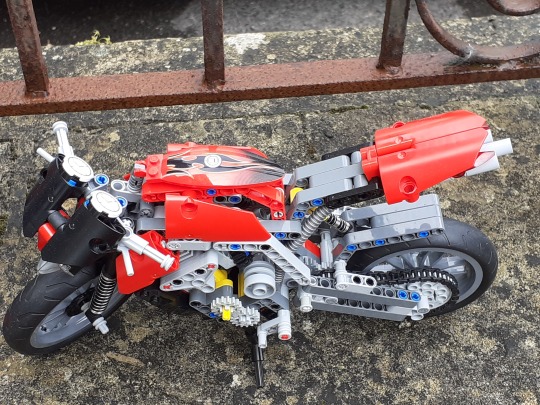
The big BMW GS1200 is an ugly brute of a bike in reality, but the Lego model of it is fabulous with the unique telelever suspension and huge pannier boxes... even if the flat twin engine is a bit lame looking with a huge gap between cylinder and head.
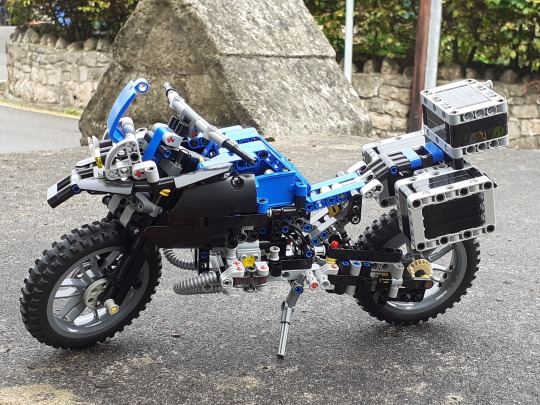
The truth is that no Technic motorbike will ever be perfect, although the Street triple does come very close. Compared to these, the Ducati feels like a rushed and unfinished model, which is a real shame given (and I say this a dedicated Suzuki owner) the absolute beauty of the real thing.
So, what can I do next with this bloody thing, it’s not like I can chuck a motor on it and set it off across the car park like I can do with the Corvette they released this year, is it? Wellllllll…. It would be rude not to try and this has been for a while now, an on going project for me to build an actual working Lego Motorbike, running on Technic Power functions kit. To date and prior to this new Ducati, I have had a single working prototype model that was able to ride and steer just like a real motorcycle. A moving weighted brick causes the bike to lean over, which steers the bike. As the weight moves back, the bike stands up again and continues in a straight line. It is not yet perfect and I have lost it under a couple of cars as I experiment. I tried to modify the Ducati chassis to accept this steering and drive set up of a pair of motors and a battery pack and the result was more ugly than me with a post migraine hangover, having woken up with my head covered in drool!
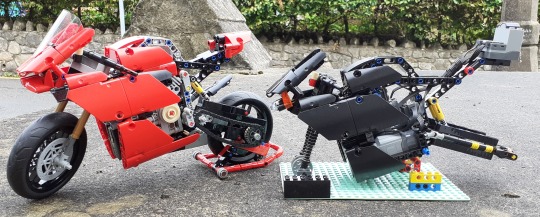
Sadly, the chain drive could not deliver the power needed to spin the wheel fast enough with enough torque to propel the bike, so I had to resort to a shaft drive on both sides of the wheel replacing the swing arm. By the time I was finished, the final bike looked like a cheap Fake Lego rip off and when I tested it on the smooth tarmac of the car park, it fell over after moving less than a foot!
So that is it for me. I give up. I have tried time and time again and I simply cannot make a working model Ducati motorcycle using Power Functions. If you look on You Tube, others have made working models and I have no idea how they have done it. One person has used a Buwhizz unit, which over volts the motors giving the bike a real blast of speed. But for those of you with a Physics mind, the way a bike works is super intricate and has nothing at all to do with centrifugal force (yes, I am aware that this is a misnomer, but it has been used for decades to explain a complicated process). Do go and look up how motorbikes steer and balance because the in-depth science of it is fascinating. No really, it is fantastic and for years I have thought so wrongly about how it all works. In the mean time, if any of you out there can figure out how to make a Power Functions controlled motorbike, I shall take my hat off to you. You are clearly a better builder than I.
youtube
youtube
#Ducati#lego technic#motorcycles#afol#Lego Group#Model motorbikes#Power Functions#Lego motorbikes#triumph street triple r#BMW 1200 GS#Lego MOC#Lego builder#Adult builder of Lego
1 note
·
View note
Photo
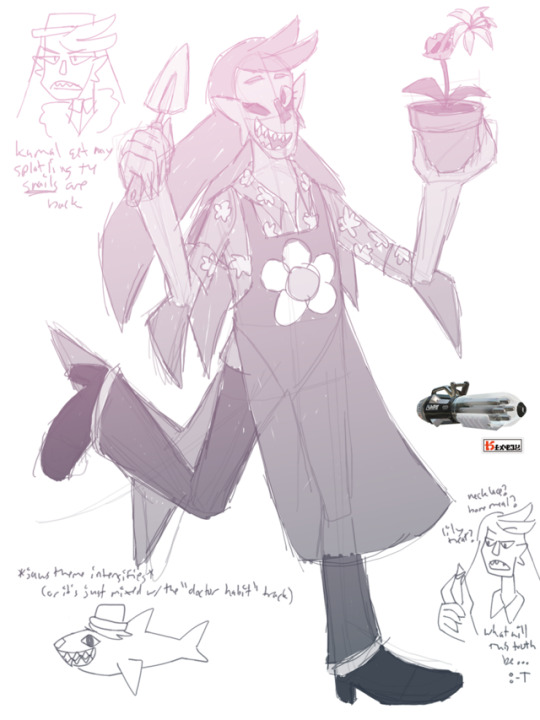
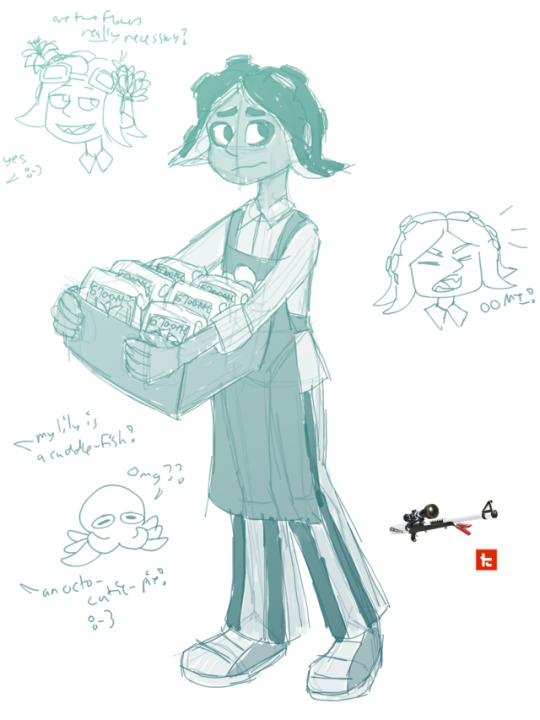
OKAY SO NOW I HAVE SOME DESIGN CONCEPTS FOR MY SFMxSPLATOON AU HERE YOU GO and now I’m gonna try to run down what this is all about outside of the braindump post that I kept adding onto.
Splat For Me - A Summary
The basic gist is that Habit owns a flower shop in Inkopolis and Kamal is his partner of both the business and romance types. Habit’s a shark, specifically a porbeagle (I’m gonna refer to him as a “Sharkling” due to working on similar logic to Inklings and Octolings), and Kamal’s an octo. The flower shop would have an in-game function kinda like a combination of the Crust Bucket (in that they have floral accessories that players could add to their hat/clothing for exp boosts, cash boosts, and temporary ability add-ons) and Salmon Run (in that you’d get another play mode where you fight weird enemies, more details below).
Sharkling Habit
I had a hard time makin him not look like Garbage so my efforts should be appreciated at some level. I know the only precedent for sharks in the Splatoon universe is Fuka Bottom of the Bottom Feeders (one of the in-universe music groups that AREN’T Squid Sisters or Off the Hook, look ‘em up), but they’ve got that “I’ve turned this shark vertically and am now looking at their mouth and underbelly” look to ‘em that I most definitely did not want, but I managed to make something more in my vision yaaaaay
Habit managed to get away from his nasty abusive parents before becoming a dentist in this AU (besides, being a dentist isn’t THAT lucrative when the dominant species doesn’t even have bones let alone proper teeth), so he’s not Dr. Habit here, he’s just Boris the flower shark. He’s gotten a lot of attention for his little flower shop, partly because the kids participating in turf war are getting some really good use out of the shop’s floral accessories and partly because they like coming around just to see Habit. S’not every day that you get to hang around vertebrates in this society, and they think his teeth are cool. Yup, that’s why I made him a shark, to make the too-many-teeth face not so unnatural. And being a shark, sometimes those extra teeth push themselves forward and knock out the old ones, which if still in decent condition never go to waste. The really nice-looking ones get turned into authentic shark tooth necklaces (after they’ve gone through a good wash, of course, don’t wanna give the customers his mouth germs), the others that don’t have any significant wear and tear get either ground into bone meal for his flowers or occasionally just shoved whole into the soil, with the erythronium responding to these treatments the best.
While there is some flower growth going on in the shop itself, most of the work there is keeping them healthy for sale and the major growth time for the flowers are off-site in various greenhouses that he refers to as Habitats. (before he had these set up, he was caught several times trying to grow flowers in the Kelp Dome and subsequently removed, took five times for him to realize that maybe he shouldn’t be doing that and also maybe don’t try to swipe a nearly-ripe artichoke on your way out gdi) They’re a bit more than just a normal greenhouse, actually; they’re self-contained areas that seem to be made with materials and techniques that are incredibly similar to Octarian technology. How’d he get ahold of that stuff? No one knows, not even Kamal, and he’s the most likely source of such tech who’d be close to him. One thing that is for certain is that he’s procured something that lets non-inking beings use ink-based weapons, and it’s been incredibly helpful given certain recent developments...
Turns out that his Habitats are starting to come under fire from some very tricky troublemakers. Weird little crafts somehow breaking in from the skies, piloted by...snails? Are they really snails? They certainly don’t look like the Super Sea Snails that everyone’s used to, they look more like the typical image of a UFO piloted by snail-like creatures (snailiens?), but they’re here and they’re hungry and they’ve got a taste for flowers. And Habit’s friggin’ pissed. That’s where the player would come in if this were a real game element: once you’d get to a certain freshness level, you’d make your way to the flower shop only to see Kamal manning the counter instead of Habit, and he’d suggest you go help Habit deal with his pest problem because you “look like you’re pretty capable with slingin’ ink”. After a tutorial where you learn how to deal with the big boy snailiens, you could join up with some other players and take ‘em on. You would, of course, be rewarded handsomely for your help.
Funny little image I also had in mind: he’s been known to get stuck in shark form at inopportune moments, and when this happens he’ll need someone to crack his back to make it easier to shift back into humanoid form. No one knows how to handle this unless they’ve done it at least once because no one else around him has booooones XD (also his humanoid form is prolly gonna still have green skin despite no part of the porbeagle being green because I don’t currently feel comfortable assigning natural skintones to any of the SFM characters who are canonically green/blue/purple/etc, unless their canon design makes it Very Obvious what natural skintone would be most likely, ie. Tiff)
Octoling Kamal
Kamal was significantly easier to work with due to my experience with drawing Octolings already hahaha
Kamal’s the assistant manager at Habit’s flower shop, which is basically a fancy way of saying he’s the only other person there who could legally be a full-time employee. He handles most of the logistics of keeping the shop stable, because as much passion the boss has for their work, passion alone can’t pay the bills and he’s often a tad too distracted to deal with the numbers and paperwork. They work pretty well together, even if they do both have a tendency to goof off on the job.
I seriously doubt that Marina and the various incarnations of Agent 8 were the only Octolings to migrate topside after the events of the first game, so Kamal was probably one of several who found a way out. I haven’t hammered this part out yet entirely, but I’m pretty sure that he would’ve been on staff for a weapons/tech r-n-d group before leaving at his first opportunity and grabbing some random gadget in the process. He hated the place he ended up emerging in because it was near a small town where everyone was so spread out and him being used to (not necessarily comfortable with, just used to) constant sounds at all hours made the silence of just the first night unbearable. So he tried to hop a train to any urban area that he came across but in his haste to get topside he forgot to bring any moneeeyyy, not even Octarian money just no money at all, left it all behind like a goof. He ends up freaking out to himself because even though he’s got a valuable Thing on him it’s not like the train people are gonna recognize it as anything but junk or even be able/willing to accept it as replacement for standard currency, then out of nowhere this huge-ass shark man just shows up and buys a ticket to Inkopolis for him? Okay, sure, he’ll take what he can get, even if the guy was all “u owe me a ‘favor’ ;-)” once they were on their way. And of course that’s how he met his future boss and bf. ;P
At some point Kamal gets a little jealous of all the kids having fun with the turf war stuff and kinda wishes he could try it out at least once, but of course that’s kid stuff and he’s got Adult Responsibilities to worry about... Oh wait, there’s actually an adults’ league? And Habit’s insisting on giving him time off to go try it and see how it is?
(also those flower seed bags say “bloomy” in one of the Inkling alphabets, and yes it WAS a “woomy” joke on my part)
Other details (to be expanded upon)
Putunia and Flower Kid are often seen at the flower shop, even though I don’t have any designs for them yet). Putunia is there so often because she’s Habit and Kamal’s adopted kid, and while she REALLY wants to get into turf war she’s far too young. (if you’ve ever seen the Inkling growth chart, she’s at stage 3 of growth) Flower Kid’s there because they are a part-time employee, often delivering products around town, but they spend enough time with their employers and Putunia that they might as well be their honorary child as well. They’re old enough to participate in turf war, they’re just not interested in doing so.
#splatoon#smile for me#splat for me#dr boris habit#kamal bora#putunia mollar#flower kid#au concepts#habismal#i guess?#yeah that's the tag pretty sure#i can't even say it's just implied it is Right There in the open#i kicked over a big ol' can of ship and it's spilling all over the floor good lord someone help me clean this up aaaaaa#sfw
10 notes
·
View notes
Text
Fantasy Biology: Winged Humanoids (feathers)

What fantasy setting hasn't considered plonking some winged humanoids down in it at some point? Whether they're angels or birdmen or something a little more left field, the basic premise is that somehow this basically human-shaped being received a pair of functional wings stuck to its back. It's very tempting to just 'magic' this through but if we were going to try to make this function in a biological sense, how would be go about it? It's a significant challenge because while most birds are designed for flight, humans are basically designed to fall out of trees.
The first bump in the road to creating our winged humanoids is that these creatures have six limbs, something no living vertebrate species currently has. In addition to having an extra pair of limbs to accommodate in the body, the wings and arms are typically depicted arising from roughly the same anatomical location. That's already a very crowded torso, and it's only going to get worse as we stack on the flight muscles.
Shoulder joints, whether for wings or arms, are highly mobile. They move in multiple different directions and can rotate (compare this to an elbow which really only has one possible movement). However, if you place a second shoulder joint on the back of a humanoid who already has a shoulder you don't have room with all the associated muscles to allow full movement of both. Something has to give.
And let's face it, it's going to be the humanoid arms. You're not sticking wings onto this creature just for them to look good, you want this thing to fly.
So the avian shoulder joint needs to be prioritized, an as part of that our winged humanoid most likely needs its chest to become more rounded. Human chests are typically flattened front to back, but flighted birds are typically rounded. The arm shoulders would potentially need to become more vestigial, with reduced movement laterally and above the head. This lets them still be functional for handling objects in front of the creature or for carrying things, but they cannot move into the way of the wings.
As for the wings themselves, the sheer wingspan a humanoid would need to be able to 'soar like an eagle' would be hugely impractical, something like 6 or 7 meters, and the weight of those wings then becomes a huge issue. So 'soaring like an eagle' is probably out, but what about 'hovering like a hummingbird'?

(Image source)
Hummingbirds are small and underrated, and they have a very impressive keel bone for equally impressive flight muscles. These birds are strong, dexterous flyers and might be a better model for getting our winged humanoid airborne. Such a creature may well be better suited for short, nimble flights than long periods of soaring. After all, if there is one trait humans have consistently capitalized on throughout their evolutionary history, it's our dexterity.
This means a very barrel chest for our winged humanoid, that sternum needs to become a decent keel bone to allow the wings to work in the same way.
Now, lets think a bit more closely about those glorious feathers, in whatever colour they come in. Birds spend a lot of time preening and maintaining those feathers, and their beaks and necks are adapted to allow them to do that. The human body doesn't quite bend that way, but we do have hands and finger nails. One possible solution is to modify the nails of these creatures to perform the same preening function as a bird's beak, though there are still some spots on the wings which would he difficult to reach, and communal preening is likely important for this species.
As a side note, the 'hair' of the head may also be replaced by very fine feathers, similar to that of the emu for a 'hairy' look while still retaining avian features. For the same reason, we might find these creatures actually have scales on the extremities of their limbs, as birds do on their feet.

(Image source)
Internally, there's a bit more we can modify other than just slapping wings onto a human. Firstly, water is a huge component of out body weight and modifying metabolism towards uric acid excretion instead of urea could help make the body physically lighter and more water efficient. Replacing the fat in large bones with air sacs can also hep reduce weight, but will potentially make those bones more vulnerable. For flight, the species would also benefit from a higher calorie, low fiber diet.
Some parts of the skeleton, thoracic spine in particular, would probably need to be fused to aid flight, but this shouldn't impact the overall flexibility of the organism.
One point of contention is whether winged humanoids would have a diaphragm or not. Birds and reptiles (other than crocodillians) don't have a diaphragm, which means they're dependent on body wall movements to breathe. Functionally though this might not make a big different to your setting, unless you're squeezing them or cutting them open.
So with the above in mind, here are some possible variants you could consider:
Clawed: These creatures retain a primitive claw or two on their wings to stabilize themselves against cliff faces or large trees. They are relatively well camouflaged when pressed flat against such surfaces.
Divers: These winged humanoids use their wings for underwater propulsion rather than swimming, gathering up all sorts of crustacea and treasure from the ocean floor before sunning themselves for hours. While capable of flying, they rarely do so.
Micro: These miniature flyers were once mistakes for fairies, thanks to their diminutive size and bright colours. They do best when housed in a colony with lots of space to fly
This Fantasy Biology post has been brought to you by Dr Ferox’s fantastic Patreon supporters. You can support the blog and choose the next species to be covered from $1 a month
660 notes
·
View notes
Photo
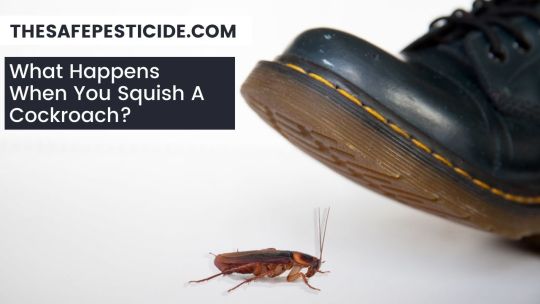
What Happens When You Squish A Cockroach? What Happens When You Squish A Cockroach? When suddenly faced with a cockroach, your first instinct may be to step on it. However, some people are hesitant due to urban myths. For example, you may think squashing a roach will release its eggs, allowing more to hatch. Others claim that a crushed roach will give off pheromones that attract other cockroaches, but they are baseless myths. If you squish a cockroach, it will die. Roaches do release a pheromone upon death, but it's a warning, not an invitation. Roaches will avoid other dead roaches unless they're starving. Stepping on roaches won't release eggs. Very few species carry their eggs with them, and if one does, the eggs will get crushed along with their mother. With that said, squishing a roach takes special force. Cockroaches have hard exoskeletons that protect them from getting bashed around. They will survive being stepped on if you don't mean it. Be sure to inspect the body for the right amount of lethal damage. Listen out for a popping sound to indicate that its exoskeleton has cracked.
What Happens When You Squish A Cockroach?
Roaches can die when you step on them. However, for the average person, you'll find this is trial and error. Many people rarely use the correct amount of force to crush a roach. To do it properly, you shouldn’t just step on a roach with the intent to kill it. You should intend to squish it out of existence. If that seems like overkill, you should consider how much force a roach can withstand.
youtube
Why Didn’t My Shoe Crush A Roach?
As invertebrates, their organs and muscles are completely shielded by hardened exterior skin. This is called an exoskeleton or shell. The main component in exoskeletons is chitin. That’s comparable to keratin, which makes up horns, claws, and hooves in other animals. Exoskeletons provide insects with a proper frame for their muscles. Without it, their segmented bodies would fall apart. That's why rigidness is vital when it comes to exoskeletons. Even their apodemes (ingrowths that aid with the muscles' attachment) are twice as stiff as the tendons of a vertebrate. Knowing all of this, it's no wonder cockroaches are difficult to kill even when getting stepped on. They can handle 300 to 900 times their body weight. Worse yet, they can squeeze through 4-millimeter crevices because of their great flexibility. Depending on the sole of your foot, the cockroach can easily contort around the tread. It may come out of the ordeal relatively uninjured.
Does Squashing a Cockroach Kill It?
However, that doesn't mean that squishing a roach doesn't work. This can kill it if done right. Squashing can be the most effective way to ensure a roach's death. These insects can play dead at a masterclass level. Just because they're holding still doesn't mean they're dead. Likewise, their regeneration abilities mean they can walk away from devastating injuries. But what can't a roach regenerate from? An entirely crushed body. If the roach is flattened out and pulverized, it cannot recover from this amount of damage. You can dispose of it how you please. You'll know a roach is squashed correctly if you hear a popping sound.
Why Do Cockroaches Pop When You Step On Them?
Roaches pop when their exoskeleton cracks. After all, the material that it's composed of is thick and hardy. If damaged enough to break, it's similar to snapping plastic. With a cracked exoskeleton, the cockroach will no longer be able to control its muscles. Even if it's not killed on the spot, it will not be capable of movement afterward. That means it will starve to death if left alone. A cracked exoskeleton also exposes its organs to damage. The shell itself may crumble inwards and pierce its soft guts. Without the shell structure to encase the organs, the force of your foot will proceed downwards. This can and will smash the roach's insides, which should cause immediate death. You should be able to confirm this visually.
What Does a Squashed Cockroach Look Like?
A properly-squashed roach will be surrounded by evidence of its death. This includes:
Pieces of the cracked exoskeleton
Droppings
Crushed organs
Dismembered limbs or antenna
It will also secrete a white substance. Many people confuse this for milk, but it's blood. Cockroach blood is white due to a lack of hemoglobin. That's a red protein in charge of carrying oxygen through a vertebrate's body. As mentioned, roaches are good at playing dead. Don't let them fool you. A cockroach that is not squashed correctly will not die; it will only be stunned into defecating. Cockroach droppings look like small brown specks. It may seem like coffee grounds are surrounding the roach, but nothing else. In this case, you can't trust its injuries will finish the job. You'll need to brace yourself and smash it again.
What Happens If I Only Squash Half a Cockroach?
The last moments of a half-squashed cockroach vary greatly. It will depend on which half was squashed. To us, it may seem like the uncrushed half of the roach is just flailing around. However, for the cockroach itself, the sensations can range from extreme confusion to nothing at all. That’s because cockroaches have two brains. One is in their head, and the other is in their posterior. The brain located in the head is in charge of:
Limb regeneration
Senses
Memory
Hormone secretion
Suppress reproductive behavior
The second brain located in the back is considered to be a more primitive brain and is in charge of:
Sexual activity
Maternal instincts
Triggering apparent death behavior
Sensory information
What If I Crush The Head Of A Roach?
When scientists cut off a cockroach’s head, they found that limb regeneration was no longer possible. It didn’t matter that the roach was technically still alive. If a cockroach's head is squished, it will stay alive for 10 to 20 days. As long as the temperature is kept at 75.2 degrees Fahrenheit and the humidity is 80 percent, it only dies through starvation. Cockroaches have ganglia dispersed throughout every segment of their bodies. As such, their limbs will still be responsive despite the crushed head. Even without a head, the second brain can still perform primitive functions without the primary brain's direction. When ready to copulate, male roaches will twist their bodies into an S-curve. Usually, it's the head brain that regulates this behavior through hormones. However, when researchers ligated the head of multiple male roaches, they could still halfway twist their bodies into the S-curve. This posited a compelling theory: When cockroaches lack a head brain, their second brain takes over.
What If I Crush The Butt Of A Roach?
Researchers found that the memory of a cockroach is affected when their second brain is missing. Despite their memory, cockroaches require their second brain to learn and retain any information. That's because they rely on their lower body to send sensory cues to the head. The first brain cannot function properly without that second brain. As such, a cockroach with a crushed lower body will struggle to find its way back home or look for shelter. Without the second brain, the cockroach will not receive enough sensory information to know what objects are in the way. It will fumble around aimlessly or attempt to, depending on how many legs it has left. Eventually, it will starve to death or be eaten by predators.
If You Step On A Cockroach, Does It Release Its Eggs?
A popular myth says that cockroaches will eject their eggs upon being crushed. This can leave you terrified to smash one. After all, it gives you only two choices:
Step on it and risk spawning more roaches.
Let the pest out of your sight as you get insecticide, tissues, or a jar.
The good news is that this is false. Cockroaches do not release their eggs when they're stepped on. That's for two obvious reasons:
Most Roaches Don’t Carry Their Eggs
Most female cockroaches carry their eggs in an ootheca. An ootheca is an elongated egg mass containing as many as 30 to 40 cockroach eggs. However, some species produce less than that. According to the Department of Zoology at Oxford University, ootheca are hardened structures made up of the same protein as a cockroach’s exoskeleton. As such, the protected case is incredibly resilient. It's usually shaped like a pill, brown or black, and has a leathery texture. Most cockroach species find multiple small, damp crevices to lay their eggs in. They will hatch weeks later. Since they do not carry their ootheca with them, you can step on the roaches worry-free. You will not spread the eggs around.
Stepping On A Roach Kills The Eggs
With that said, a few species carry their eggs at the end of their abdomens. Even rarer, some species carry eggs inside their bodies. These have a live birth. If you happen to step on a cockroach of this variety, don't worry. The eggs will be crushed underneath the weight of your foot. The babies will not survive. The egg cases may be tough enough to protect the unborn roaches from bacteria and weather. However, it can't protect them from getting stomped on by a human. What if a couple of eggs do survive? In this improbable scenario, they would be born in an exposed environment. They would have trouble completing their molting cycle and reaching adulthood. Without the comfort of their small holes, they would likely die in short order. There is also a chance that the ootheca attached to a female roach is empty. Ootheca has a small ridge running along its side. This is where the cockroaches breakthrough when they are ready to hatch. Once the nymphs are out, the ridge closes itself back up again. It can sometimes take a few hours for the ootheca to detach itself from the mother roach. So, after stepping on a cockroach and seeing what might look like an ootheca, don't panic. It could be empty.
Does Killing a Cockroach Attract More?
Cockroaches do release a pheromone when they die. This smell will alert other roaches in the area and send a message. However, contrary to popular belief, this isn't a signal to invade. It's a warning that says, "there's danger, so run away." When cockroaches find a good spot to turn into a nest, they release a series of pheromones. That signals to other cockroaches that a new home can be made there. On the flip side, when cockroaches die, they also release a smell that lets other insects know where the death occurred. According to biologist David Rollo of McMaster University, cockroaches release fatty acids (oleic acids, specifically) when they die. His team attempted to extract the cockroach-attracting pheromone but had difficulty doing so on live roaches. Instead, they crushed cockroach parts and spread them around potential nests. Here, they found that cockroaches would avoid those places at all costs. Through a series of experiments, his team discovered that cockroaches could warn each other. They keep away from places where other roaches die because the smell produced by fatty acids indicates danger.
Does A Dead Roach Attract Hungry Roaches?
The corpse of a dead roach may be an appealing meal to others of its kind. However, it's not immediately an attractant. Cockroaches do engage in cannibalistic behavior, but only when they have no other choice. Cockroaches will always prefer eating something other than their own if they can help it. If you see one eating a roach corpse, it definitely means it’s starving. Usually, cockroaches can be seen eating their own in clean houses where they have trouble finding food. As such, you can step on cockroaches worry-free. As long as you apply the right amount of force, they will die without consequences. Keep sharing What Happens When You Squish A Cockroach? with your friends and family members. Read More: https://thesafepesticide.com/what-happens-when-you-squish-a-cockroach/?feed_id=30&_unique_id=61136c63f1906
0 notes
Text
Clueless About Chiropractic Care? Take A Look At This
New Post has been published on https://thebestsolution4u.com/clueless-about-chiropractic-care-take-a-look-at-this/
Clueless About Chiropractic Care? Take A Look At This
Clueless About Chiropractic Care? Take A Look At This
You’re about to learn how you can get the relief you need by paying a visit to a chiropractor. Perhaps you have thought about it in the past, or maybe you were skeptical about the benefits. What you’re about to read will have you signing up for an appointment with the proper knowledge.
It is never too early for chiropractic care. Often children are born with problems such as subluxation. Don’t be afraid to have your baby attended by a skilled and qualified chiropractor. Early care while the bones and structure are still malleable can make a tremendous difference in your baby’s overall health and well being.
Do you suffer from fatigue? Many times fatigue is caused by tense neck and back muscles. By repositioning your back, the nerve flow is increased which allows the muscles in your back and neck to relax allowing you to rest comfortably while you are sleeping; thus, improving your fatigue by getting the necessary rest.
Chiropractic care focuses on your skeletal and nervous system and the functioning of your brain. The central nervous system and brain control all the functions of your body, so regular chiropractic care can lead to excellent overall health. When your central nervous system is functioning properly, all of your autonomic functions, such as heartbeat, breathing and digestion work unimpeded.
Are you dealing with high blood pressure issues? Many studies have indicated that adjustments to your neck’s first vertebra can help this. Properly manipulated vertebrae allow good nerve supply to your heart, which helps your body regulate its blood pressure.
Steer clear of any chiropractor who claims that chiropractic can cure certain diseases. There’s no proof whatsoever that chiropractic can do any such thing. Any person saying so is essentially a quack just after your money. Do yourself a favor and look elsewhere for the quality care that you deserve.
If your chiropractor wants to put you through neck manipulation, ask him for a clear justification. Because neck manipulation puts you at risk of damage to the vertebral artery, it should be a last resort and should only take place when there is a pressing need, so if your chiropractor uses this for all patients, go to another one instead.
Birth processes that are used today can cause chiropractic problems in infants. Traumatic birth syndrome results when subluxation of the spine is created during birth. This causes damage to the neck and the nervous system of newborn babies. For this reason, it is very important to have your baby checked by a chiropractor early on.
Did you know you can receive chiropractic care while your pregnant? Many women do not realize how beneficial this can be. The added pregnancy weight can put pressure on your back and neck causing discomfort. Studies have shown that manipulations by a chiropractor can relieve up to 85 percent of back pain associated with pregnancy.
Stay consistent with exercise. One key to a healthy back is flexibility and mobility. Through exercise, you strengthen the muscles around the back and associated with it. By increasing the flexibility of these muscles, you are less likely to put undue strain on your back and keep it from causing pain.
When looking for a new chiropractor, ask your friends and family for advice. You can generally expect an honest answer from friends and family. Ask them who they see and how much they pay for a visit. It’s often wise to visit a professional that someone you trust has had personal experience with.
You should always meet a chiropractor prior to engaging in any chiropractic services. A chiropractor can change the way that you live. If a bad one works on you, though, things can get worse. Go with someone that you trust. Before you schedule any adjustments, always have a consultation with the chiropractor to ensure that you understand the treatment process in full detail.
Your chiropractor should not be attempting any spinal manipulations before ordering a diagnostic x-ray or MRI so the nature of your ailment is very clear. This will ensure that you get proper chiropractic treatment. Don’t let your chiropractor manipulate your body until you get these tests. Instead, find another chiropractor.
To strengthen your core without damaging your back, take sit-ups and crunches out of the equation, because those movements can worsen the pain you feel in your back. Try the plank pose from yoga instead. This involves lying down on your stomach and then raising the body so that you balance on toes and hands, as in the top of a push-up. Hold this plank as long as you can.
If you are constantly coming down with a cold, consider consulting a chiropractor. Studies have demonstrated that people who regularly get chiropractic care have fewer colds, with less severe symptoms. If someone has a bone that’s misaligned in their spine or “subluxation”, it can interfere with the nervous system and weaken their immune system. Chiropractor adjustment corrects this problem and restores proper nerve supply.
To help your neck relax from a day at the office, use the headrest in your car. The natural direction for the neck to point while you are using your computer is down, so counteract that by pointing your chin up and leaning your head back while driving. This gives your neck muscles a break from the long day.
To maintain a healthy spine while you are asleep, you have to maintain the natural curves of its structure. You can sleep on one side, with a cushion between the knees, or on your back, putting a cushion beneath your knees. In either position, also put a small cushion beneath your head, and position it so it also supports the neck.
Are you confident that a chiropractic care appointment is exactly what you need? If so, then it’s about time you physically found out about the benefits. It’s going to be an adventure that no doubt will leave a smile on your face. Read more about other’s experiences, and prepare for your own.
0 notes
Note
have you guys ever watched the docufiction film The Last Dragon | A Fantasy Made Real? Its a fictional documentary set in an alternate universe where dragons were real
I wrote a few reviews abt it quite a while ago, but the longer one is p old and kinda cringey/incorrect in certain places, so I’ll run down my basic thoughts here
also if anybody wants to watch this film, here’s a link to it. I first watched this when I was a wee lil dragon-fanatic, and I’m obviously a sucker for faux-documentary/field journal fantasy media, so this movie holds a special place in my heart. HOWEVER, as I will explain here, it unfortunately gets a LOT of things wrong. it’s def got some positive qualities (which I will also describe), and it’s a fun watch, but DO NOT take this movie as an accurate assessment of what dragons could have been under different circumstances
WHAT THIS DOCUFICTION GETS WRONG*:
*I’m ESPECIALLY harsh on this movie b/c it’s a DOCUfiction. I tend to be a bit more lenient when a story isn’t necessarily aiming for a realistic setting (stylistic consistency is relevant here), but when a piece of media sets out to describe a scientifically feasible setting?? I bring the hammer DOWN
1) dear god, the anatomy is janky
the wings in particular can get RLY bad.

these wings clearly need more musculature and lower arm/’hand’ length, and a full membrane connection to the torso. they don’t even have ANY hint of integration/connection to the ribcage– no keel, no shoulder/chest musculature, not even any scapula!!
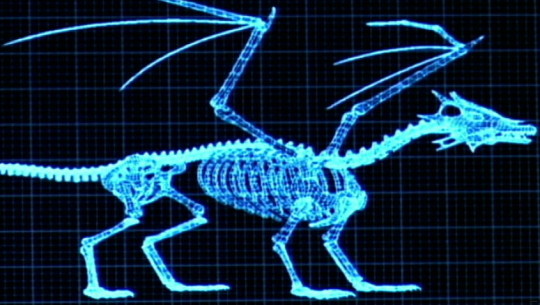
disgraceful…
while I can accept elbow spines in certain cases, I still don’t rly think they’re necessary in most cases– ESPECIALLY in this case where they don’t even provide extra area to the membrane around the elbow! what’s even the point!!
also I just noticed the designers forgot to put the elbow spines in the skeletal, so I can’t even check if they were integrated correctly….. hell, looking closer, I don’t think the front legs have scapula either….. DISGRACEFUL…
the wing shoulders also need to be shifted back behind the front leg shoulders, obviously, but they ALSO ought to be shifted down more towards the sides of the ribcage. wings based high up near the spine are typical of birds b/c they’ve got specialized wing musculature that basically pulls all the wing muscles (including the “back” muscles) down under the ribcage. bat wings aren’t built for that kinda setup, thus the shoulders are based more towards the sides on actual bats. this would likely be the same for bat-winged dragons
and those aren’t even the worst wings

I legit lose my mind a little lookin at these wings like…. why no membrane…. WHY NO MEMBRANE…
also there was clearly some attempt here to give these wings chest/shoulder musculature, but the designers didn’t know how much musculature a wing actually needs (or even how those muscles need to be shaped to properly hold a body..). thus, we just get pillowy, bara-boy boobs that would be useless for flight, even if the wings themselves were actually designed right
obviously a keel is necessary for a creature this big, but even if the designers nyxed the keel, the LEAST they could do is stretch the pecs down the full length of the ribcage to properly support the torso…
beyond the wings, some of the torsos are JUST a mess
the wyvern’s torso is mostly a problem b/c of weird wing integration, but the hexapod up top just has a plain weird torso, wings or not

it feels like the designers attempted to slap canine-like front legs on an ungulate/equine chest, and just utterly failed to integrate them properly. thus, the legs are floating to the sides of the chest rather than connected to and holding it up in any substantial way
I actually see this lack of shoulder integration in a lot in dragon designs, but it’s usually a result of trying to preserve the shape of chest/throat scales, so it’s kinda weird to see on a leathery-skin design
another thing abt this particular hexapod dragon is a bit hard to explain, but the neck is like… weird. idk if it’s super apparent to others, but the neck attaches more under the skull, a bit like a dog (ignore the skeletal, it’s clearly not accurate to the dragon actually presented). however, the flow of the neck from the chest is more of a horse neck? the strong up-and-over curve of a horse neck can’t rly attach to the skull in any way except the direct back of the cranium, yet this neck attaches somewhat to the underside of the skull, giving it a VERY awkward curvature. I happened to recently answer an ask abt necks that may explain this better, but suffice to say, the neck is weird
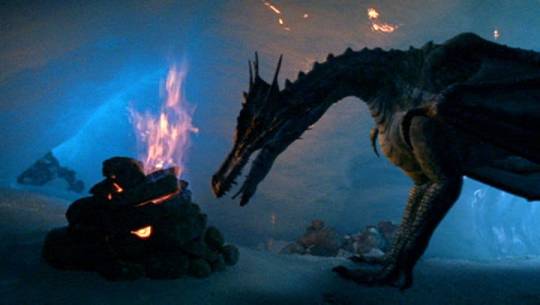
also, as u can see above, the base of the neck at the chest is super stiff b/c the animators didn’t bother to shift the mass of the chest/neck w/ the movement of the neck, which in turn makes the neck look ABSURDLY thin at angles like these
oh, and while this is certainly not the worst of the anatomical sins, the shrink-wrapping is p bad. yeah yeah, flighted creatures gotta be light, but flying animals still have SOME fatty deposits, like…. c’mon, u can SEE the cartilage rings in the throat of that poor wyvern, gimme a break… + it gets cold in the sky, where are some protective feathers/’fur’ for these guys?? especially side-eyeing the one living in the mountains. yeah I know they’ve apparently got that heat-retaining blood protein or whatever, but much like the flight bladder (which I will get to later), that’s asking me to excuse a bit much in terms of anatomy
(tho to be fair, the actual dinos featured in the film are naked and thin too so… at least this inaccuracy is consistent..)
I feel like this is especially bad w/ the heads. it looks like there’s barely any muscular support at the connection to the neck, and no jaw musculature to speak of. of course, a croc-like jaw design could layer the muscles under bone so that they’re not necessarily visible from the outside
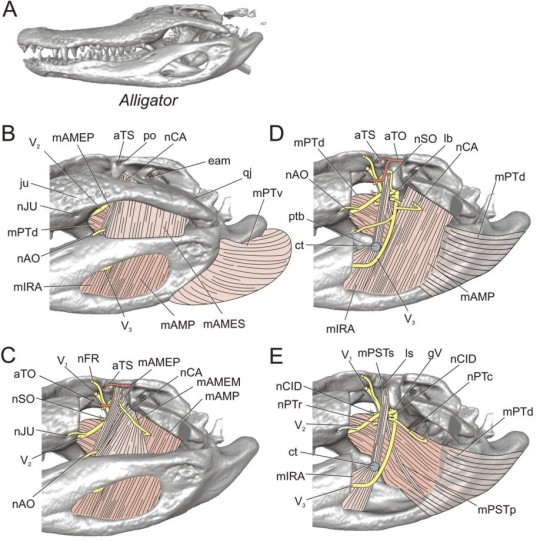
but note the mass distribution of the bones of the jaw– they still stick out a fair bit to leave room for the muscles underneath (including on the upper jaw), and more importantly, the area for basing the muscles on the lower jaw is WIDE. now dragons may not necessarily need a strong bite-force like crocs if they’re using their talons and fire for attack, but most ANY toothed-animal skull is gonna NEED a lower jaw with a wider back end to provide stable, strong support to the jaw muscles. what I’m seeing from the ‘croc-’like dragon heads in this movie (not the wyvern head so much, that actually isn’t too bad in this respect) are flimsy, cardboard structures that will warp at the slightest hint of pressure
also, the teeth on all the dragons are weirdly straight and thin? like fishing teeth? but the main dragons are all land predators– they SHOULD have thick/curved teeth. even crocs have thick, slightly curved teeth, get w/ the program!!
and let’s not forgot this fucker

sir… SIR, that is a muscle-less TUBE with LEGS…..
………..funny how suddenly the wiener-dragon ain’t shrink-wrapped, eh?
also this dragon absolutely CANNOT glide, no matter what kinda “flight bladders” they got, the membrane surface area is FAR too small even for gliding, I’m sorry!!
2) “evolutionary theory? what’s that??”
basically the film goes, “WHOA this dragon has 6 limbs! no other vertebrate on the planet has 6 limbs! they must have a wild genetic mutation for that to happen– oh, yep, they sure do!” and just… leaves it there
the evolution of 6 limbs in any evolutionary tree similar to Earth’s is literally so complicated, I have an entire post dedicated to breaking down JUST that concept. the way this movie so briefly presents this “wild mutation” doesn’t even BEGIN to cover how incredibly difficult it would be to shift something as hard-wired as vertebrate limb number from four to six
what’s even MORE frustrating tho is that this movie’s timeline for evolution doesn’t even make SENSE! supposedly their oldest dragon is the wyvern– the tetrapod. then that TETRApod somehow led to the HEXApod marine dragon. what in the world?? WHERE did that other limb set come from? WHY is there another limb set suddenly???
as I explain in that post linked above, it’s practically impossible for another functional, full limb set to evolve in a complex vertebrate– that’s why it’s most reasonable for hexapods to evolve long before tetrapods set the standard, and the two evolutionary lines would go their separate ways. there’s a small chance a limb set could evolve properly into a small, early tetrapod (tho even that is a long-shot), but in a LARGE vertebrate whose entire physiology revolves around their current tetrapodal, bipedal setup, as this movie suggests w/ their wyvern? hell nah, not a chance
and there are def other evolutionary problems throughout– generally just the fact that dragons seem to change VERY little, ‘aesthetically’ speaking, despite so many years of evolution and adaptation to wildly different environments (looking at the marine dragon..). yet when the dragons ARE markedly different from one another (wyvern vs. hexapod), it only brings up more problems, as covered above. like it’s all just so vague and ungrounded in any real evolutionary reality
also this post pointed out further problems w/ the evolution I didn’t even think abt (like the forest dragon being a contemporary to the mountain dragon, despite being used as an intermediary b/t marine and mountain) so I’m rly just 🤔 abt all this
3) BAD lab procedure!!
why aren’t the researchers wearing masks? they need masks to protect the corpses from human germs, and protect themselves from breathing in anything weird that was on the corpse! and they keep touching the corpse w/o gloves, getting their human oils all over the body! have they never heard of contamination?? AUGH
there’s definitely more wrong here that I rly don’t have the experience to speak on (and some of it I’m willing to excuse for the sake of a short, dramatic film– like the team having a whole lab setup right on the mountain), but the cross-contamination is what rly bothered me.
WHAT THIS DOCUFICTION GETS RIGHT and/or FUN:
1) realistic, cool behavior
the dragon behaviors featured are actually realistic, and downright cool at times!
screaming to both call for help and hurt an opponent’s ears; flashing wings to warn off opponents; mimicry to trick prey; that KICK-ASS courting ritual (if not displayed a bit awkwardly in terms of body positioning); the fiery brooding method (if we at least assume egg physiology that could handle and require that kinda direct heat, which I don’t think is…. necessarily outside reality… perhaps… maybe…)– these are all awesome examples of neat behavior
2) flight bladders? kind of??
this one is in the “got it right” list based more on potential than actual application in the movie
see, the idea of a flight bladder is p cool! the source of gas from digestion is completely reasonable, and it makes sense as a way to help a huge creature relieve some of the stress of flight
plus, the connection w/ fire-breathing is super interesting! it’s a very reasonable give-and-take system, and I like it a LOT. so this post pointed out the problems w/ having a flight system that relies on a product also used up by a different system, so now I can’t even give it that much credit lmao
however, the flight bladders in the movie are used to excuse some of the worst wing anatomy I’ve seen passed off as “realistic designs”. flight bladders may make up for *some* shortened wing length, or flight endurance, but they CANNOT make up for the problems I described in the “got it wrong” list
3) fire-breathing mechanics
if we now ignore the problems w/ this gas system being directly connected to the flight system, the fire-breathing is decently grounded in reality! the designers not only took into account the fuel source (gas from digestion), but also ignition source (platinum deposits). both of these sources are super interesting to me cus’ they technically utilize outside resources, which is not usually the case w/ a lot of fire-breathing mechanics I’ve seen
also love the specialized mouth anatomy– a scaled inner mouth and protective palate-valve make perfect sense to protect the dragon’s innards from fire, esp since the fire is igniting towards the back of the mouth. though the source of ignition being so far back in the delicate throat is itself suspect, and makes me wonder why it wasn’t simply ignited up towards the front of the mouth to prevent injury….. man I can’t give this film an inch w/o taking a mile back, huh!!
-Mod Spiral
14 notes
·
View notes
Photo
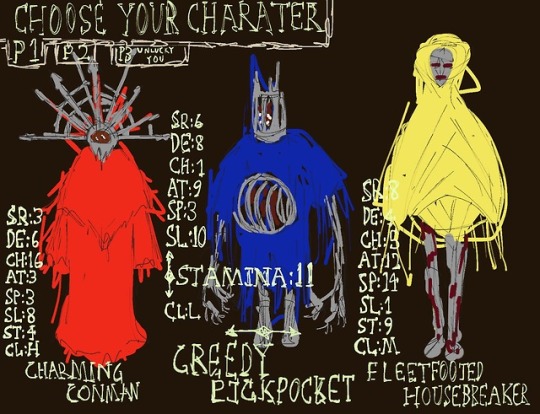
I had a long and realistic dream last night about finding an emulated version of a 90s cult classic video game called “Thief’s Apprentice”. The general atmosphere of the game is incredibly bizarre and similar to other weird 90s games like Eastern Mind: Lost Souls of Tong-Nou, Myst, LSD Dream Emulator, Majora’s Mask, and Paranoiascape. It’s an open-world 3D game with the really chunky prototype low-poly graphics and it is famous for almost every moral choice eventually leading to your death. The plot of the game is about a Master Thief raising three lost boys and teaching them how to steal. Master Thief grows old and one day, tells his sons to travel to a prosperous city called Veilheim and steal as much as they can in order to prove themselves. There is a whole lot of story, characterisation, hidden stuff, and plot twists, but the only real goal of the game is to get as rich as possible and bring as much of it back to your ageing father as you can. If you want, you can leave, pick up some colorful broken glass from the front yard and immediately come back, then Master Thief says he is so disappointed in all of you, and the game ends there.
Some other stuff in the game:
You’d expect the city law enforcement to quickly link the new crime wave with the three corpses held together with metal and neon-bright cloth, but everyone looks just as bad so you don’t even stand out.
The entire country is infected with a flesh-eating mutagenic plague, but it isn’t a big deal. In fact, people without any permanent injuries or deformity are seen with suspicion and prejudice. Kaolin, a friendly but lonely kid with blue hair, is one of them.
For single player mode, the in-story explanation is that you go to Veilheim, another bro goes to the island port town of Malassol, and the other bro goes to the religious capital in the mountains, Gehenna. In multiplayer, there is split-screen so you can have one player as Charming Conman crashing a dinner party and convincing all the guests to leave with him to an even better party, another as Greedy Pickpocket taking personal items from the guests when they enter the streets, and the last as Fleetfooted Housebreaker looting the villa now that everyone’s gone, and it’s Lit as Hell.
The music is either non-existent or really bad ambient electronica.
There is a powerful necromancer doing weird stuff in the wastelands surrounding Veilheim.
The plague only affects vertebrates, so insects and snails are seen as “Perfect Forms” and if you are seen hurting them in public you will get arrested. It’s okay to squish maggots, worms, and mosquitoes and things like that if they are literally eating you, though.
Because most people are decomposing, smelling good is considered an important part of polite society. The starting perfume you have access to is “Four Thieves Vinegar” which actually exists in real life.
Greedy Pickpocket can rotate the angle of the metal slats on his belly like window blinds to hide objects he swallowed or to quickly unload goods.
The Mayor is the richest person in the city and he has the biggest villa and estate, and most normal playthroughs of the game are focused on getting into it.
There is another villa owned by an agriculture scientist that is an endless maze filled with priceless plants, fountains, and golden sunlight that is impossible to leave unless you find the one random greenhouse with a small statue of the Floating Goddess in the corner and pray to her for so long that you start to float too, then you float out a high opened window and that’s how you escape.
If you get too drunk or injured and pass out in the worst part of town, you may wake up chained to a slave ship on its way to Malassol. You can try to escape, but you must do it within 5 minutes of waking up before the ship gets too far from land and you drown trying to swim back. You can choose to stay aboard the ship and try to find your brother in Malassol, but when you reach the island you are immediately forced into a mining minigame that ends when you die.
You can get join a local election and get elected to public office, whereupon you can start your cushy life of white collar crime.
If you play as Charming Conman, you can marry pretty much everyone.
The game doesn’t have save files or player settings after you start, so if you start playing 3-person multiplayer, you’d better be able to keep it up.
The main square of Veilheim is infested with children with plague-induced broken bones held together with thick layers of gauze and ceramic tiles playing street hockey who will kill anyone that’s shorter than them. Nobody knows where they come from. Do not crouch in front of them or you will be beaten to death. There is a plot event where the Hockey Children completely overrun the entire plaza and judicial district, and the other children are forced to hide on top of huge stone pillars.
There is another plot event when an army of zealots from Gehenna invade Veilheim to purify the city of the plague, and depending on what you do to stop them, such as deliberately getting arrested to inform the city guards, walking way out into the wastelands to tell the Necromancer, sabotaging the army’s supplies yourself, or nothing, vast sections of the city might be destroyed or abandoned.
If you look hard in the Mayor’s records, you can find out that Greedy Pickpocket used to be a foreign princess who refused an arranged marriage with the Mayor’s son so he had her killed. Later, the corpse was revived by the plague, but Pickpocket is so unrecognisably rotten and was raised as a boy for so long that he doesn’t really care.
There is a fetch quest where a group of debutante girlfriends removed their organs to fit into their fashionably tight corsets, but they lost them all by accident.
You can play the entire game without stealing anything and get rich from legitimate business, but your dad will still be disappointed in you.
The only bro capable of fast travel and teleporting between warp points is, logically, Fleetfooted Housebreaker.
Malassol is a slave/prison colony and Gehenna is obsessed with remaining plague-free to the point of burning anyone with obvious injuries alive, so it’s implied that if you play single-player, your brothers both die.
The Necromancer is actually responsible for the plague and killing him will halt his evil magic, but if you do, the everyone suddenly feels the horrible pain from their injuries and anyone whose bodies can’t function without the magic in the plague dies, including you.
Master Thief is the single oldest living being and it turns out that he and Necromancer used to be so close that when Master Thief got mortally wounded, Necromancer created the plague just to keep him alive, but it got out of hand and here we are today.
Master Thief and Mayor of Veilheim have a secret deal where the Mayor kills people, imbues their corpses with strange magic, and gives them to Master Thief to train. The message “You found 12 AMBER BEADS ... but you can’t possibly carry anything more.” actually teleports the items into the Mayor’s estate. You can find the room if you look hard enough, but it won’t have any significance unless you remember the exact items you couldn’t carry.
It’s implied that Master Thief had an emotional crisis after watching the children murdered by the Mayor being revived as malformed zombies by the Necromancer’s plague, and he sends you to Veilheim to wreck both of their plans as revenge.
Even though the game as a whole is bleak and gruesome, the interactions between the brothers are genuinely cute.
I also dreamed of looking at Thief’s Apprentice Let’s Plays on youtube and finding the “Grand Theft Auto: Veilheim” challenge where you had to steal the Horseless Rockgrease Carriage belonging to an influential nobleman and rampage for as long as possible without getting off. This is challenging because the carriage consumes rockgrease extremely quickly, you can’t refuel without getting off unless the fuel is already in properly-sized tanks, the carriage is extremely valuable so the instant you are seen with it sends the city guards on high alert, and the carriage itself will explode if it hits anything too hard. The world record so far is 16 hours 11 minutes and 41 seconds, done by befriending the nobleman to secretly store enormous quantities of fuel all over his estate and escaping into the wastelands.
There’s also stupid edits comparing Master Thief to Master Chief.
#long post#weird dreams#eastern mind#myst#lsd dream emulator#majora's mask#paranoiascape#graphic injuries#i do better worldbuilding in my sleep than I do in real life and that makes me sad
25 notes
·
View notes
Text
Neck and Head Physiotherapy in Mandurah | Physiotherapy for Back Pain Relief in Mandurah
Tailbone and back pain following fall on bottom
I recently suffered a fall on my bottom whilst playing sport. I am now suffering from very low back pain and am experiencing some bladder problems. What should I do?
Back Pain can range from just a niggle to major injury. The physiotherapists at Mandurah Physiotherapy treat a lot of clients with Back Pain. It is very common in our society and the majority of the population will suffer from back pain at some point during their lives.
Occasionally falls on the bottom will produce some instability and injury to the sacroiliac/coccyx joints. These joints are where the tail bone attaches to the pelvic and connect to the spine. Often if these structures are involved then bladder problems may emerge and may settle with treatment to the tailbone and a good exercise regime. There is a lot of research in this area and there is still a lot more to do however this may be the problem and help from an experienced physiotherapist is required. If the tailbone joints have become unstable due to injury to the ligaments or muscles then this needs to be addressed. The exercises that mainly need to be concentrated on are the lower abdominals, pelvic floor and gluteal muscles which are in the buttock. You may also need to concentrate on certain stretches to take the pressure off the joint. Find a physiotherapist who has some knowledge of the recent research in this area and make sure you have a full assessment to ensure the proper diagnosis is made. It would also be of benefit to talk to your G.P concerning these problems and get some advice. You may need to be referred to an orthopaedic specialist for further assessment and treatment.
Back pain, no matter how small should be looked at. The longer you live with it the longer it will take to treat and get relief. If you leave it too long, irreparable damage to your spine may occur that is irreversible. Don’t leave it in the hope that it will go away with time. Get some advice-see your physiotherapist for a full postural and biomechanical assessment of the problem.

Scoliosis
Scoliosis is an abnormal sideways curvature of the spine. Instead on of the spine being straight when viewed from the back, there is a curve to one side or the other or a combination of curves. Scoliosis is generally classed as those curves that are severe or cause symptoms. They can be idiopathic although there are other causes. They may occur due to an irregularity such as a short leg, or due to bad posture or increased muscle use on the dominant side of the body. Sometimes it can be due to abnormalities or disease of the bones, soft tissue or nerves associated with the spine. Minor curves are normal in the local population and do not necessarily need treatment. They can however cause discomfort in the back or neck and treatment will relieve symptoms.
Abnormal spinal curves require a spinal and posture assessment. If the curve is severe, a specialists opinion may be sought. All children should be assessed for scoliosis before they finish growing. If this is diagnosed early, treatment is much more effective. Treatment often consists of an appropriate exercise program, treatment and advice in order to minimise the curve and keep it mobile to avoid complications. Severe scoliosis may cause wedging of the bony vertebral segments as well as stiffness, and treatment may be needed during flare-ups. Maintenance treatment for spinal curvatures is encouraged to ensure full range and function in the back and neck.
#neck and head physiotherapy in mandurah#Neck and Head Physiotherapy in Perth#Physiotherapist Armadale in Perth#Physiotherapy for Tradies in Perth#Physiotherapist Armadale in Mandurah#Sports Physiotherapy Mandurah#Physiotherapist Armadale Mandurah#Physiotherapy for Knee Osteoarthritis in Mandurah#Physiotherapisy Mandurah#Lower Back Pain in Mandurah#Massage Service in Mandurah#Massage Service in Perth#Physiotherapy for Back Pain Relief in Mandurah#Physiotherapy Treatment in Mandurah#Physiotherapy Treatment Mandurah#Knee Pain Physiotherapy Mandurah#Physiotherapist in Perth#Neck and Head Physiotherapy#Physiotherapy Back Pain Treatment Mandurah#Mandurah Physio#Mandurah Physiotherapy and Rehabilitation#Physiotherapy for Tradies in Mandurah#Physiotherapist Armadale#Mandurah Physiotherapy#deep tissue massage near me#knee joint pain relief#lower back pain#physiotherapist in mandurah#physiotherapy for back pain relief#physiotherapy centre near me
0 notes